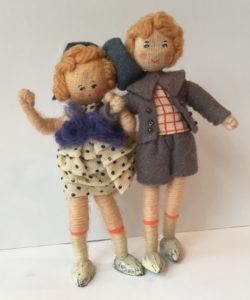
You can click on any of the topics to skip straight to them:
My sources of information are listed at the foot of the page.
The Creator
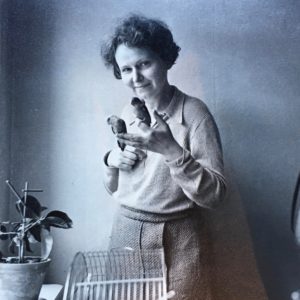
We have a Jewish German lady called Miss Margarete Cohn to thank for creating Grecon dolls.
The name Grecon is made up of a selection of letters from the shortened form of Miss Cohn’s first name (which she generally used in preference to Margarete), Grete, and her surname: GREte COhN – GRECON!
Miss Cohn was born in Germany on the 21st of December, 1894. After attending an Arts and Crafts college in Berlin she began to make sew cloth dolls and other small items.
The Grecon trademark was registered in Germany in 1920 and in 1927 Miss Cohn produced her first miniature cloth dolls.
In May 1936, aged 41, Miss Cohn fled Nazi Germany to England. She settled in London and resumed production of her dolls, registering her Grecon trademark in England in 1940.

Miss Cohn sold her dolls to large stores such as Harrods and Hamleys, as well as smaller shops. She also sold to toy companies such as Galt and Barton.
The following Toy Trader article gives a lovely insight into how Miss Cohn considered her toy-making to be very much an artistic endeavour.
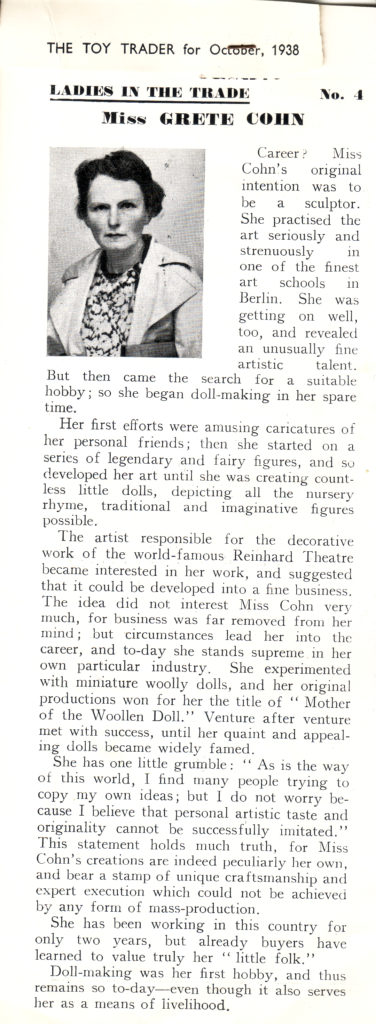
In 1947 Grecon dolls were exhibited at the British Industries Fair and ‘Grace’s Guide to British Industrial History’ contains the following entry:
Miss Margarete Cohn of 40 Streatleigh Court, Streatham High Road, London, SW16. Telephone: Streatham 0226.
1947 Listed Exhibitor – British Industries Fair. Manufacturers of Flexible Miniature Dolls for Dollshouses, Soft Toys, Artistic Toys, Artistic Novelties. (Olympia, 1st Floor, Stand no. F. 1888)
This exhibition was organised by the Export Promotion Department of the Board of Trade and, as a result of this and other such fairs (such as the 1946 ‘Britain Can Make It’ export drive exhibition mentioned by Marion Osbourne in ‘Bartons “Model Homes”‘), it seems that Miss Cohn found an additional market for her dolls in America where they were sold through large department stores and mail order companies.
I was interested to find the announcement of Miss Cohn’s naturalisation in 1951 in the online archives of the London Gazette. The entry appeared on the on the 22nd of May, in a list of “ALIENS to whom certificates of naturalisation have been granted by the Secretary of State, and whose Oaths of Allegiance have been registered in the Home Office during the month of April, 1951”:
Cohn, Margarete; Germany; Doll Manufacturer; 40, Streatleigh Court, Streatham High Road, S.W.16. 12 April, 1951.
Miss Cohn, who never married, lived alone at this address and made her dolls from a workroom there, outsourcing various stages of production to homeworkers. She was known to the homeworkers as Connie, presumably taken from her surname Cohn, which she would have pronounced ‘Con’.
In 1952, A. Barton & Co. became the main, but not sole, distributor of Grecons. This relationship lasted until 1967, while Grecons continued to be sold in Hamleys until the early 1980s.
In 1959, Miss Cohn moved from London to Haywards Heath in Sussex, and sometime in the early- to mid-sixties she moved to Hove near Brighton (on the south coast of England). She continued to produce her dolls right up until about 1986, by which time she would have been 92!
Miss Cohn died on the 31st of October, 1991, aged 96. An entry in the National Probate Calendar shows that by then she was living at 30 The Priory, St. Catherine’s Terrace, Hove and her estate was listed as amounting to £209,502, so she died quite a wealthy lady.
Construction
Miss Cohn would have made the dolls herself initially, but as demand for them grew she employed a team of outworkers to help her.
The main body of the doll is made using a wire frame to form the torso, arms and legs, with a loop at the top to which the head would later be attached.
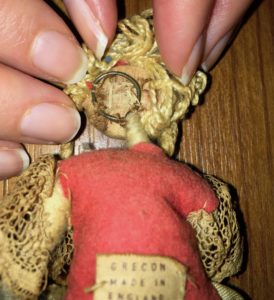
Lead feet were cast in moulds with the bent ends of the wire legs being set inside them. The exception to this was for Grecon babies, whose legs simply end in thread/woollen feet, formed in the same way as their hands (see below).
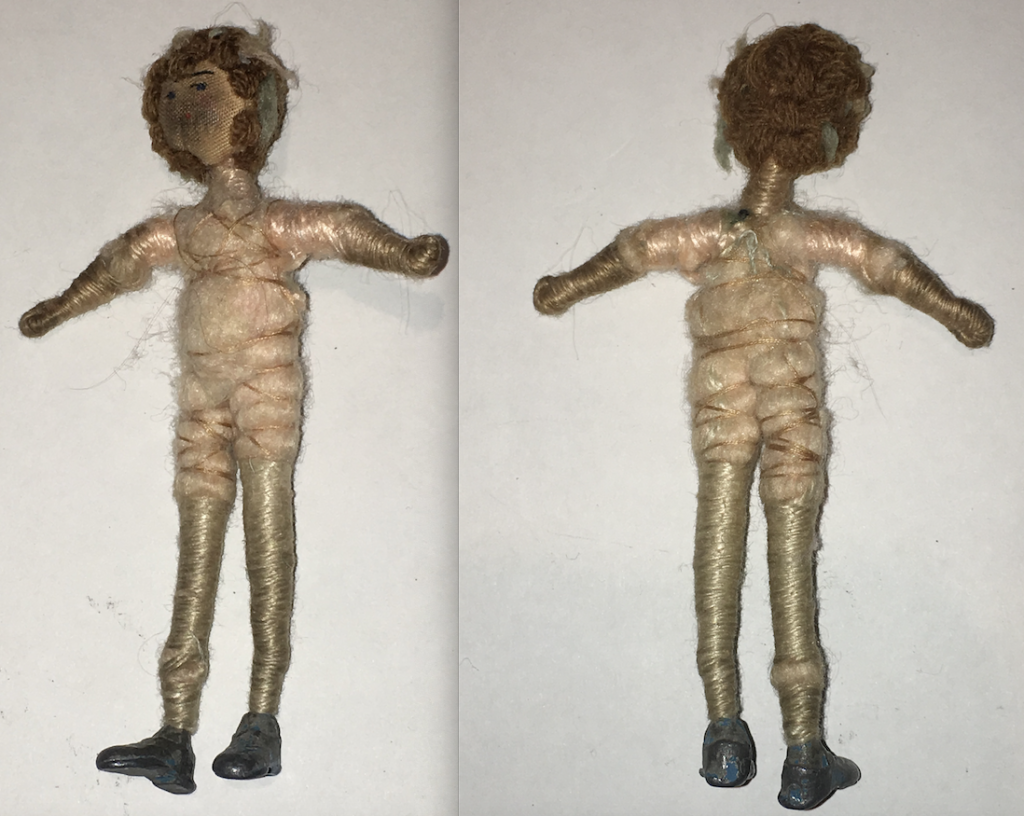
The frames were then padded with cotton waste and bound with thread or wool. Exposed areas such as necks, arms and legs were very neatly bound with flesh-coloured thread/wool or, in the case of legs these might be bound in various colours to represent stocking or socks. Hands were formed by bending the wrapped end of the arms back on themselves and tucking in the end of the wire.
Very early heads were made using a rounded wooden button, padded at the back and covered in ‘flesh’ coloured material. If you look carefully at the faces of these dolls you can usually spot the little indentation in the fabric of the face where the hole in the center of the wooden button is located.
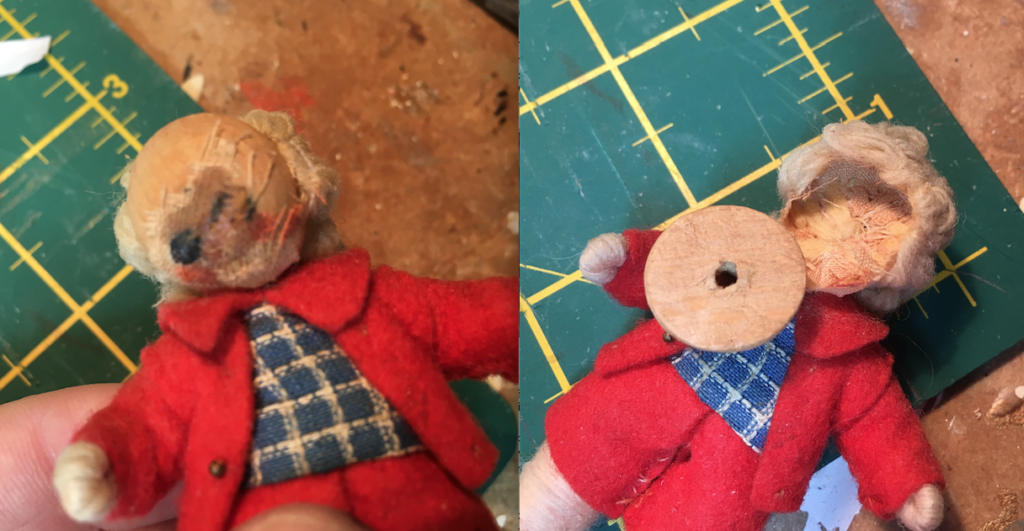
Later and more commonly, however, heads were made entirely from fabric circles, stuffed with cotton or fabric waste and stitched to the loop at the top of the wire frame.
Wool, thread or reportedly even real hair at one point, was then sewn on to the head to create the various hairstyles of the era. On some of the last dolls to be produced, the hair was glued to the head rather than stitched.
Clothes made from felt and other fabrics were then added. The outfits given to the doll reflected either the fashions of the eras or various roles such as granny, grandpa, mother, policeman, soldier, cowboy etc. – the list of different characters produced is considerable!
Facial features were painted on to the stuffed head.
Early Grecon dolls didn’t, as a rule, have labels, however, later dolls did and it was either sewn into a seam in the dolls’ outfit or attached with a few stitches, usually on the back, though I have see one example where the label is situated underneath a jacket.
Scale and Size
Dolls’ House-Scale Grecon Dolls
The best-known and most commonly found Grecons are the dolls’ house sized ones. The size of these did, however, change over the years, generally getting smaller over time.
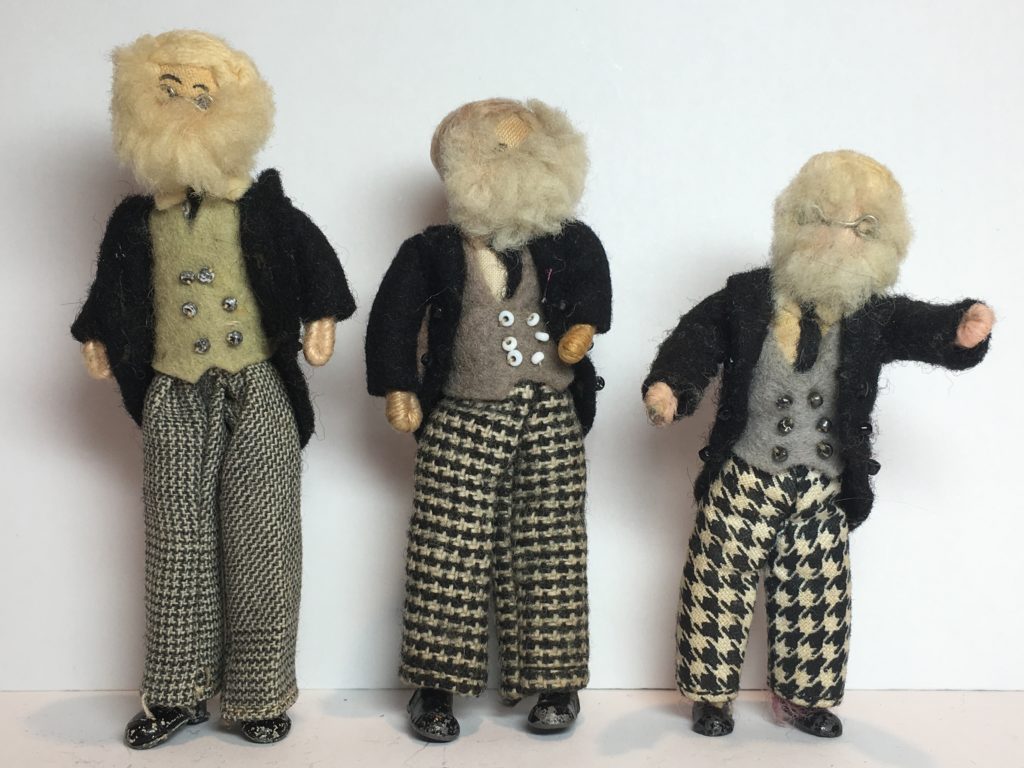
Adults are generally between 7.5 cm and 10 cm (3″ to 4″) tall, which makes the scale roughly between 1:24 and 1:18.

Children are around 6 cm (2 3/8″) tall and I can see no distinct pattern of shrinkage apart from in foot size. In fact, the latest of the children (from the 1980s), are slightly taller than the chunky early ones, so it’s no wonder they are so unstable on their little feet.
Larger-Scale Grecon Dolls

Much less commonly, larger-scale Grecons can be found. Being generally too big for the 1:16 scale dolls’ houses commonly found when they were produced, they were probably made as travel souvenirs.
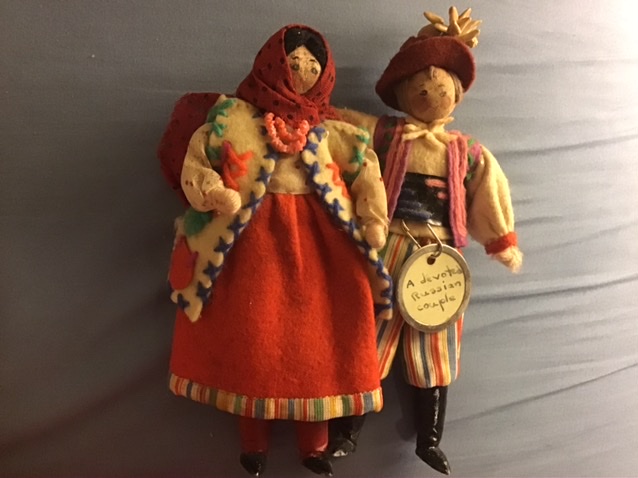

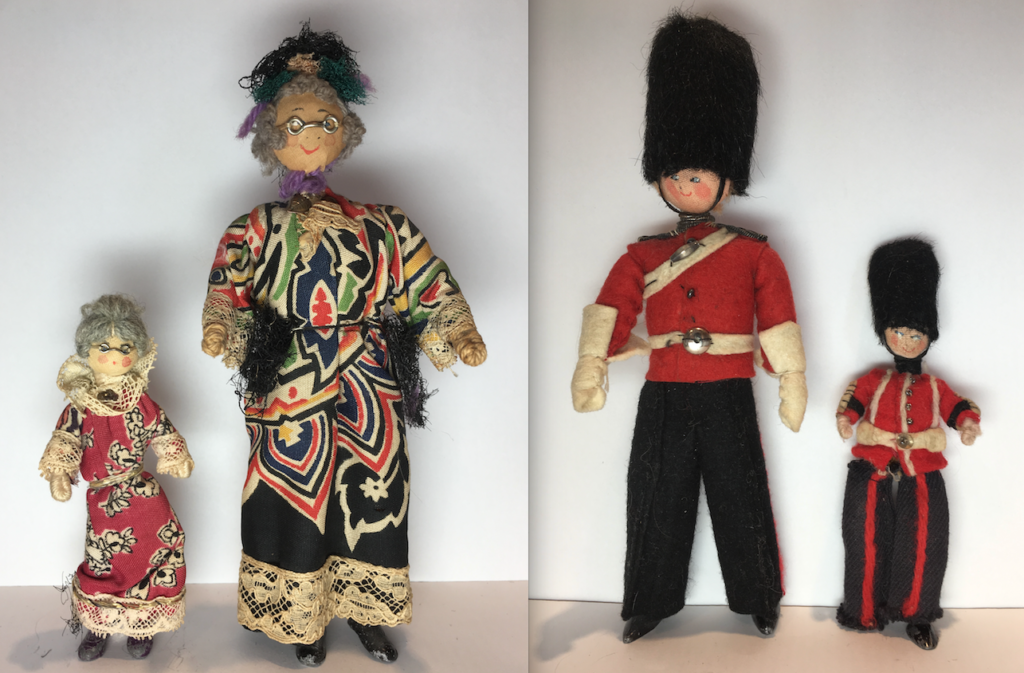
The difference in scale between the dolls’ house-scale and the larger-scale is very evident when they are seen next to each other!
I don’t own an example of a 1:12 scale baby (i.e. with shoeless, wool-wrapped feet) but there is one illustrated in ‘Dollhouse and Miniature Dolls’ by Marcie & Bob Tubbs, so they do exist.
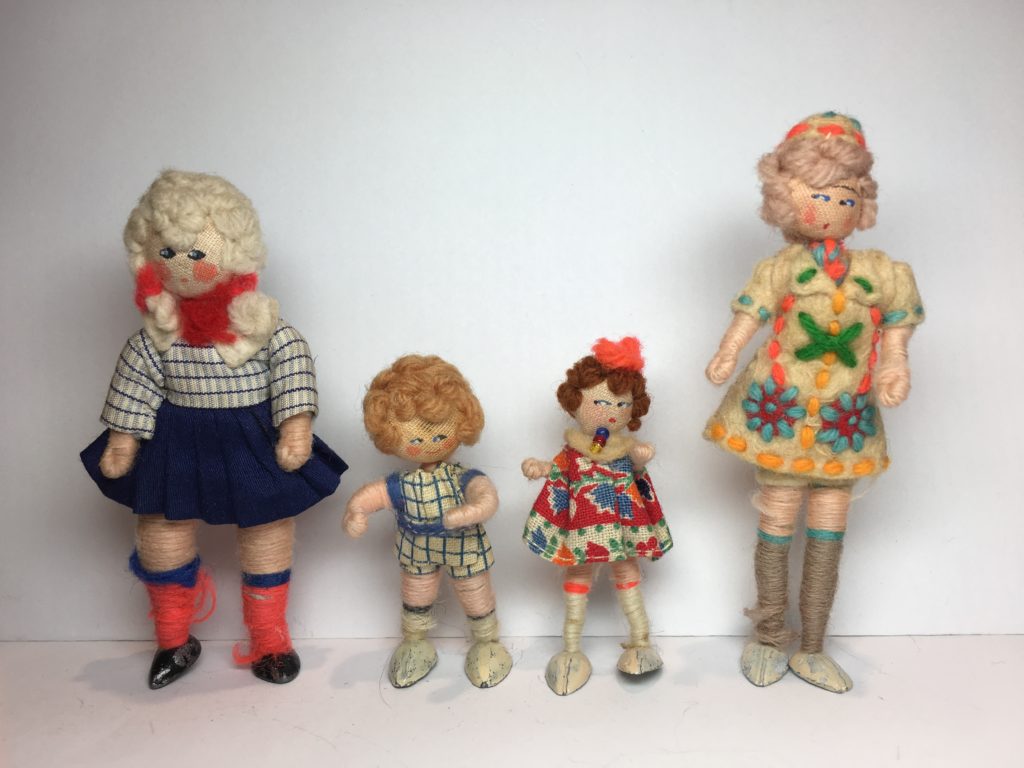
Not only did Grecons reduce in hight over time, they also reduced in stature, perhaps due to a shortage of available materials during and after WWII. The contrast in ‘chunkiness’ can be seen in the photo above, particularly when comparing arms and legs. The dolls on the left pre-date those on the right.
I would imagine that as the 1950s progressed, the continued reduction in stature would be due more to efforts to cut costs and thereby increase profit margins than to shortages in materials.
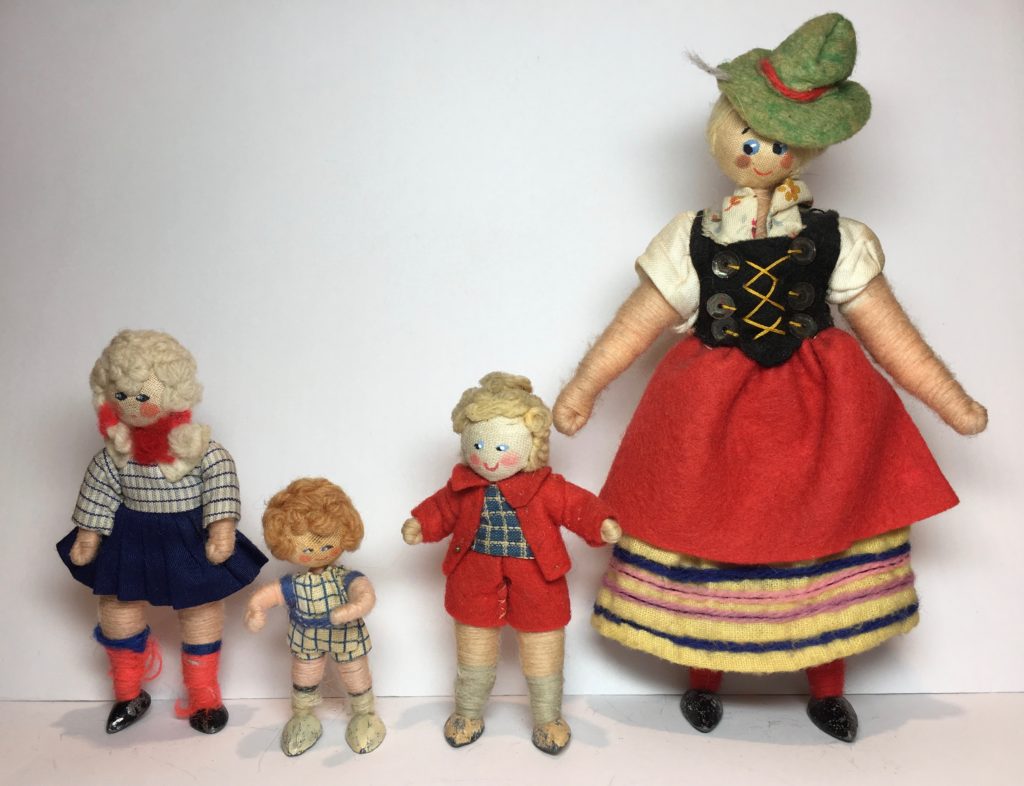
I think that the little boy in red [with replacement face] could be a 1:12 scale toddler. He might, of course, be a more grown-up dolls’ house size boy but, given that he’s only 1.25 cm (½”) shorter than the adult/teen of the same date on the left, I feel that’s less likely, and he does look nicely in proportion as a toddler to the 1:12 scale lady.
Feet
Feet were made from lead, cast in a mould with the leg wires of the body frame (bent at a 90 degree angle at the ends) set inside. The use of lead gave the feet weight and ensured that the dolls could stand unaided. However, as the feet got progressively smaller over the years, stability became increasingly precarious, with the later examples struggling to stay on their feet even when sober!
Not only did the size of the moulds change over the years but the detailing did too and I’ve found quite a variety of different feet amongst the dolls in my collection. I will attempt to show the variations here, with an indication of when they might date to.
Measurements are given for the longest and widest parts of the feet.
Part 1 – Adult Feet
1. Melon Feet (1930s – early 1940s)
The earliest feet are a distinctive ‘melon’ shape and from this, the term ‘melon-foot’ or ‘melon-footed’ has come into usage amongst Grecon enthusiasts.
Something about melon-feet that I’d failed to spot myself but has now been pointed out to me is that, unlike later feet, they all seem to be limited in colour to either black or white.
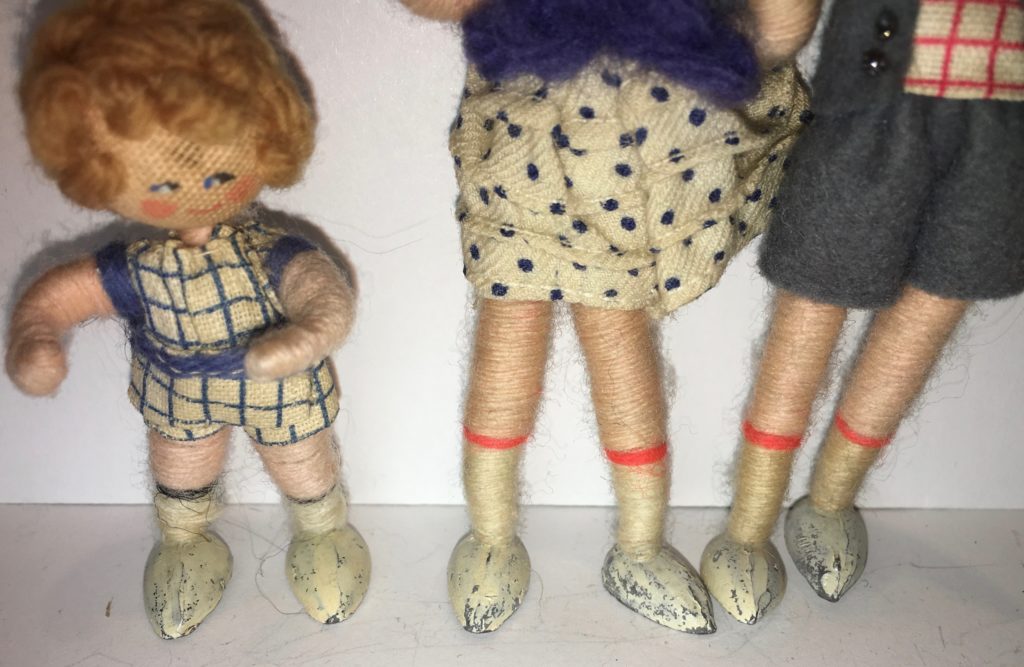
As you can see, the same size Melon feet were used for both adults and children. These early ones measure 1.5 cm (⅝”) long and 0.9 cm (⅜”) wide. Later, non-melon footed children generally had smaller feet than the adults.
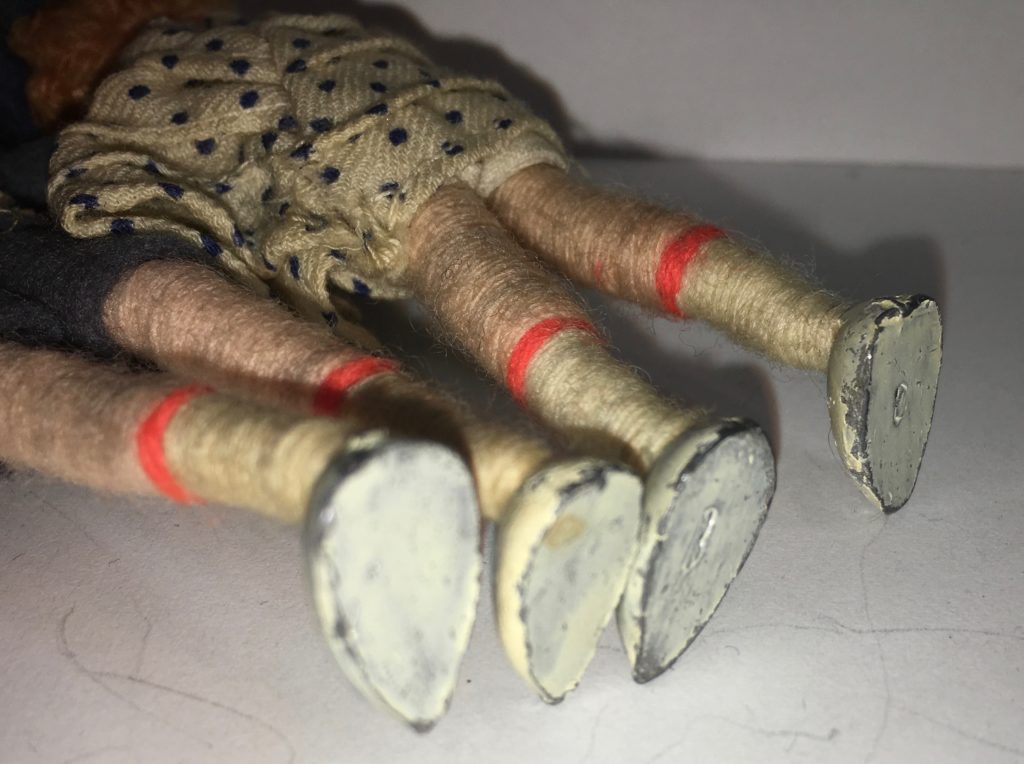
The bases of Melon feet are completely flat and on some examples you can see the bent end of the leg wire set within them.
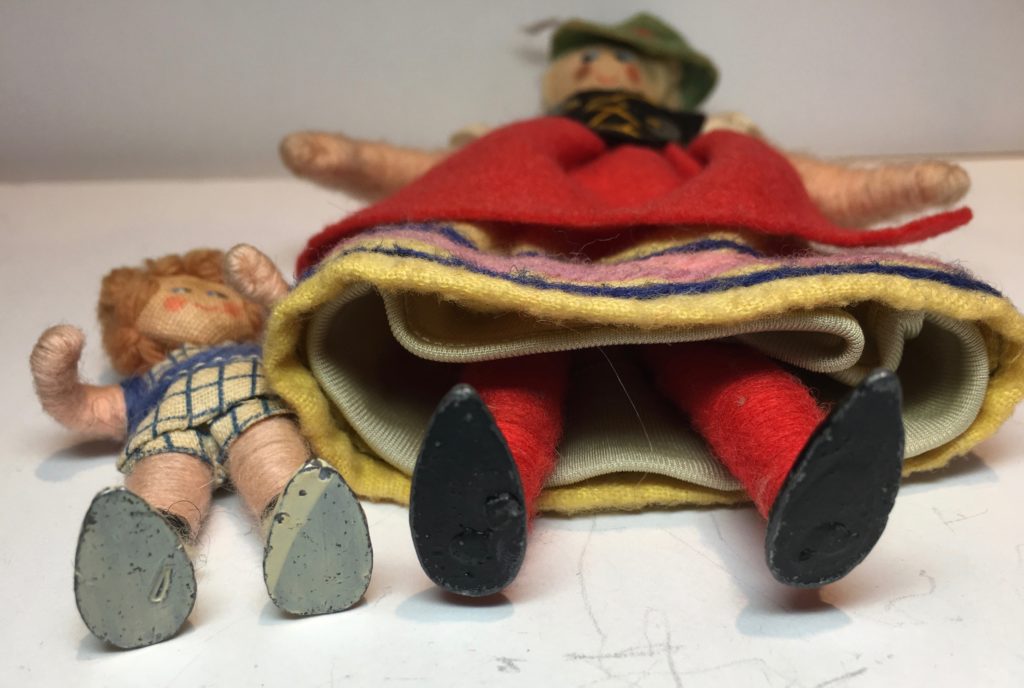
The Melon feet on my 1:12 scale dolls are the same width as the smaller ones but much longer at just over 2 cm (¾”) on this early lady.
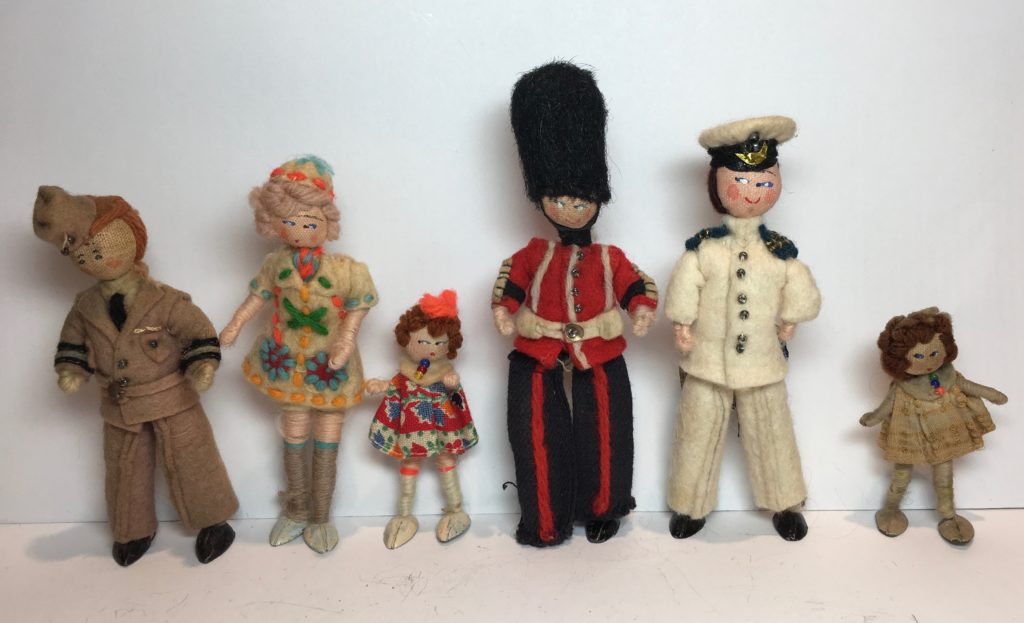
By the 1940s, Melon feet appear to have reduced slightly in size. Amongst the examples I have, just over 0.16 cm (1/16”) has been shaved off the length, and the depth of the foot is reduced too – most likely to save on lead at a time when it would be increasingly difficult and expensive to come by.
In the photo above, the early button-head soldier on the left (late 30s/very early 1940s) has full-size Melon feet, however, the other, soft-head, characters in the line-up (early 1940s) have the slightly shorter ones and these reduce in depth from left to right until the dusty little lady on the far right has very flat feet indeed.
The great advantage of Melon feet is that they are large and heavy and therefore they keep the doll nicely anchored to the floor when standing – even my one-footed Guard can stand unaided on his sturdy single Melon foot!

Unusual Feet – I have one early dolls’ house-size doll (from the Melon feet period) with completely different feet! Ludwig here has chunky black boots with Edelweiss painted on them. I initially had doubts as to the authenticity of this footwear, until I saw the same character (though in 1:12 scale), wearing the same boots in ‘Dollhouse and Miniature Dolls’ by Marcie & Bob Tubbs. [Incidentally, the doll in the book is captioned as being 1:18 scale but can’t possibly be, given the contrast in his size to the dolls’ house-sized Grecons standing beside him in the photograph.]
Wool-wrapped Feet – All Grecon babies have wool-wrapped feet, however, I have also seen examples of toddlers and older children, all from the Melon feet period, with wool-wrapped feet. I’ve also heard of the odd adult with wool-wrapped feet from that period too. My guess is that there were occasions during WWII when lead became temporarily unavailable to Miss Cohn and she and her workers had to improvise in order to keep production going.
2. Oxford Feet (Mid 1940s)
Some time around the mid 1940s, the melon feet were succeeded by what I call the Oxford feet because of the detailing in the casting, which emulates an Oxford shoe, having a distinctive toecap and other seams, as well as laces.
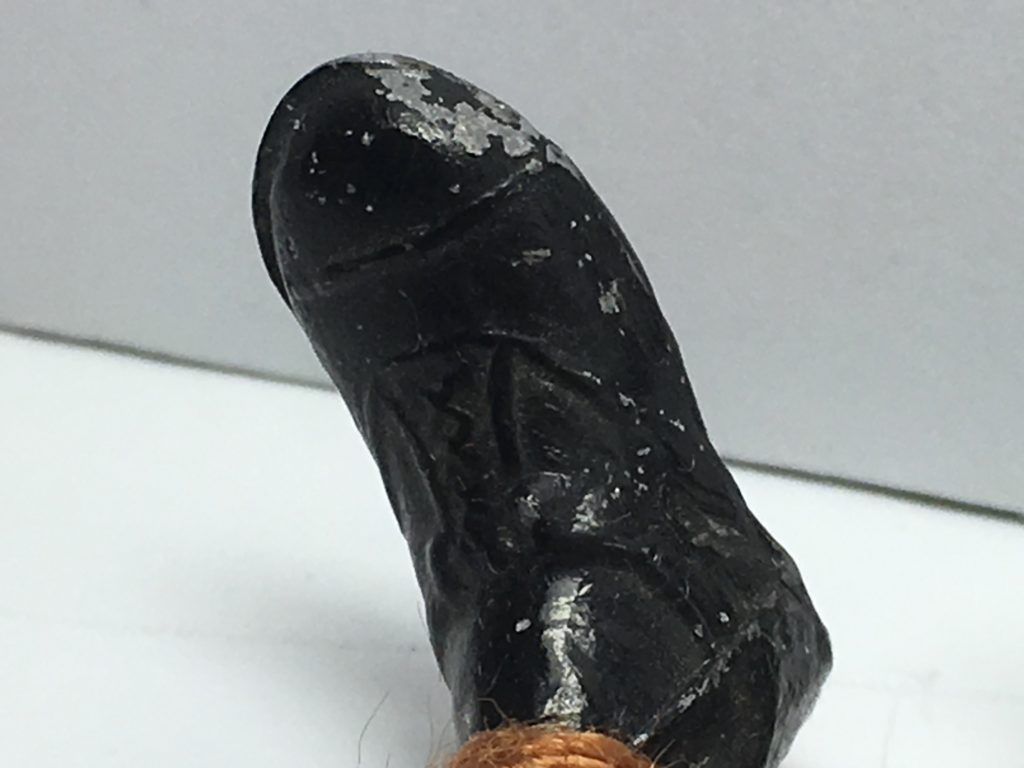
The detailing can be seen quite clearly on the feet of my 1:12 scale granny in the above photo. These 1:12 scale Oxford feet are 1.9 cm (¾“) long and 0.7 cm (¼”) wide.
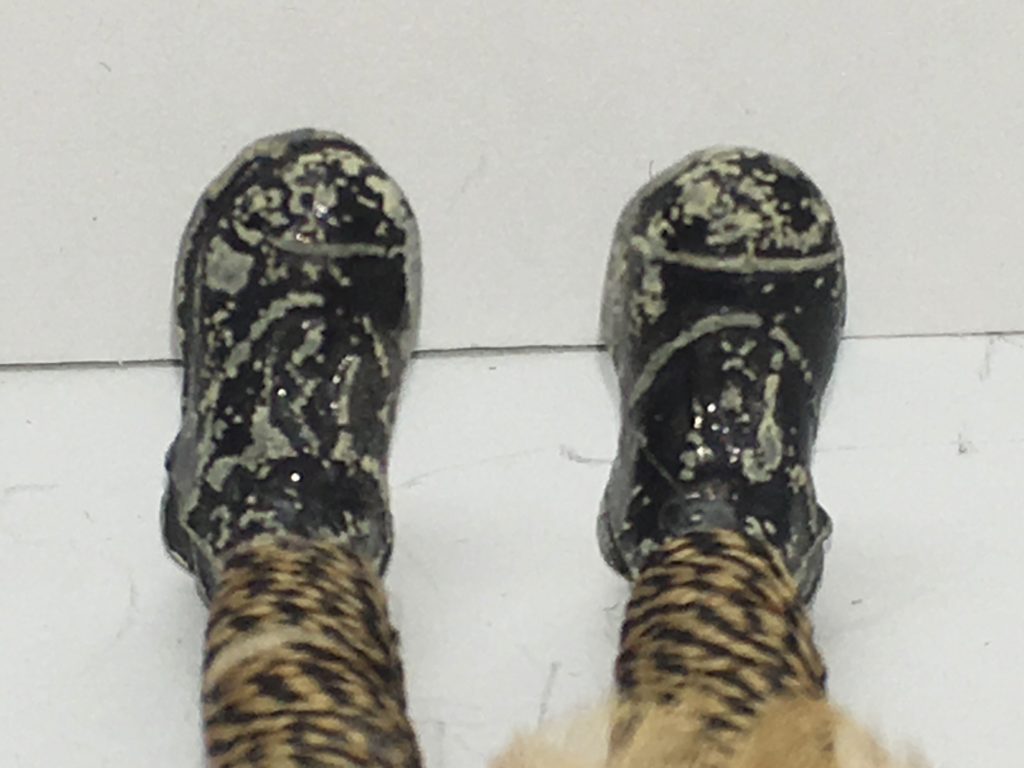
The same detailing is present on the dolls’ house-scale dolls but it’s a little more difficult to make out. These feet are 1.5 cm (9/16”) long and 0.9 cm (5/16”) wide.
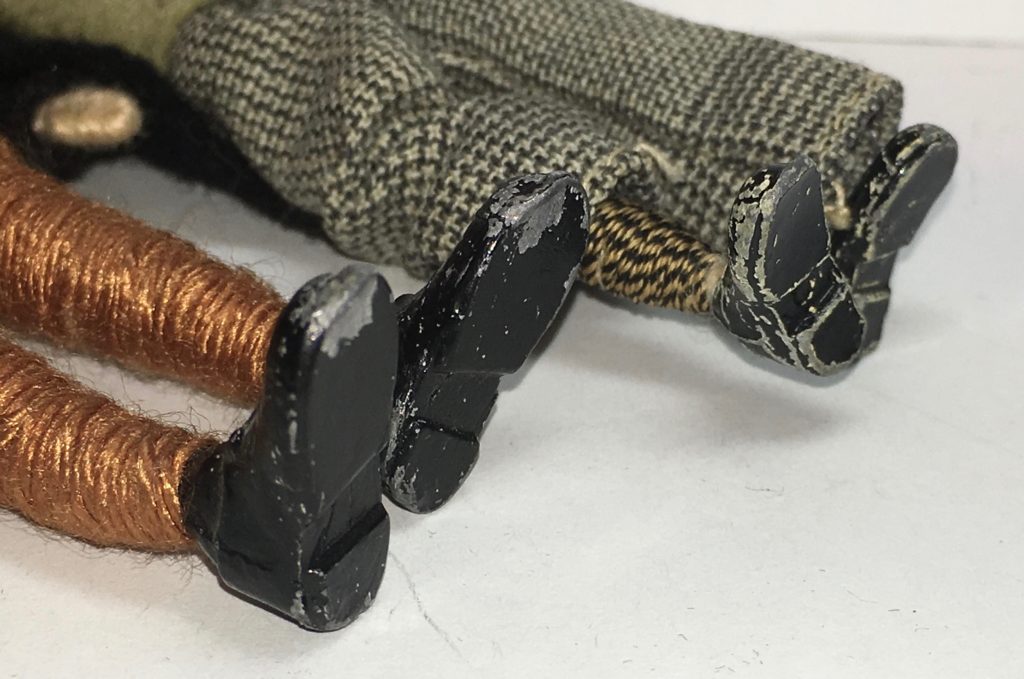
Oxford feet have an indentation on the base, giving the shoe a distinct heel.
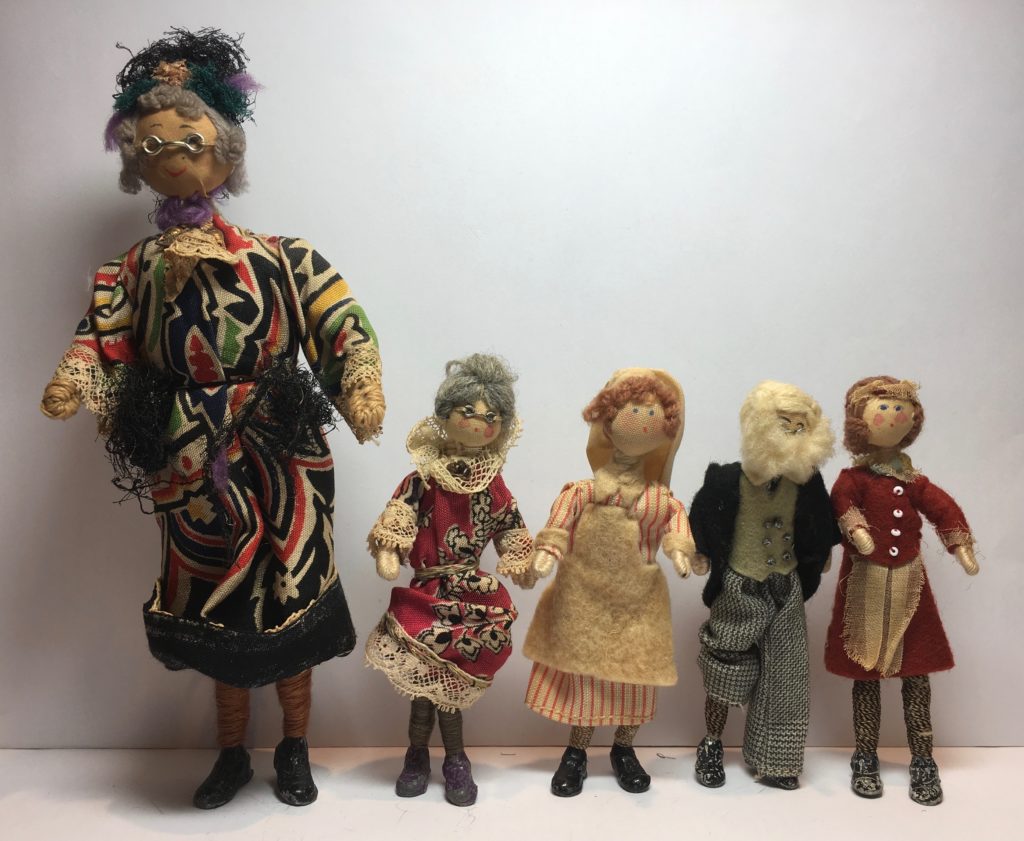
These feet are chunky, with a good weight and so the dolls tend to stand well.
3. Small Oxford Feet ( Mid 1940s – Late 1940s/Early 1950s)
The very chunky Oxford feet don’t seem to have been produced for very long before they were replaced by a smaller version, sometime in the second half of the 1940s.
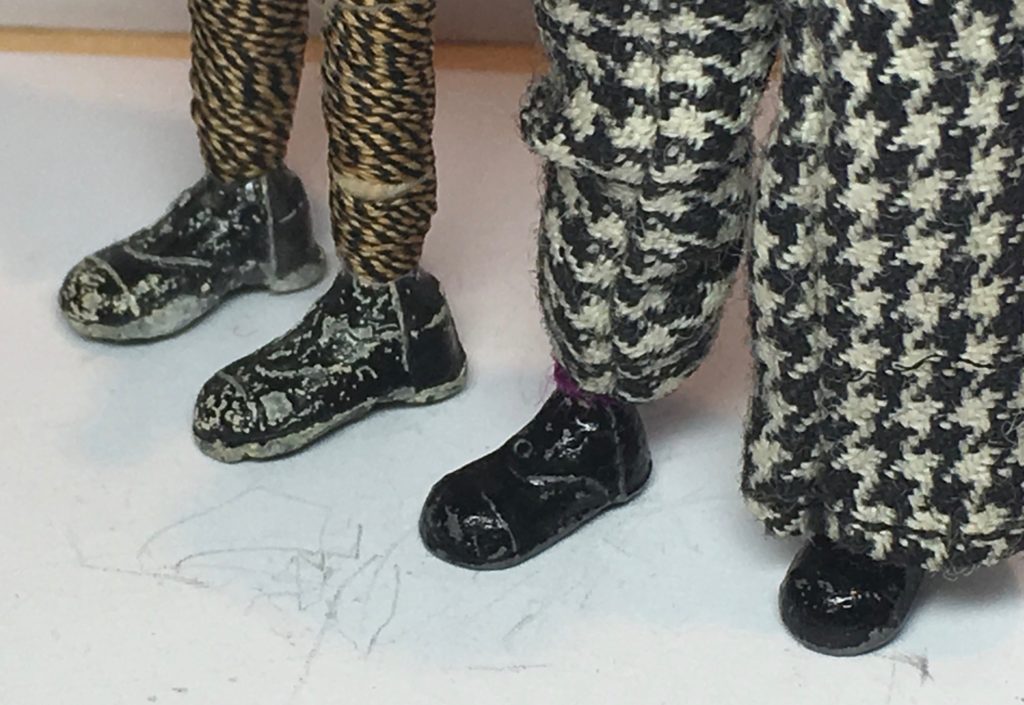
The Small Oxford is 1.3 cm (½”) long and 0.6 cm (¼”) wide.
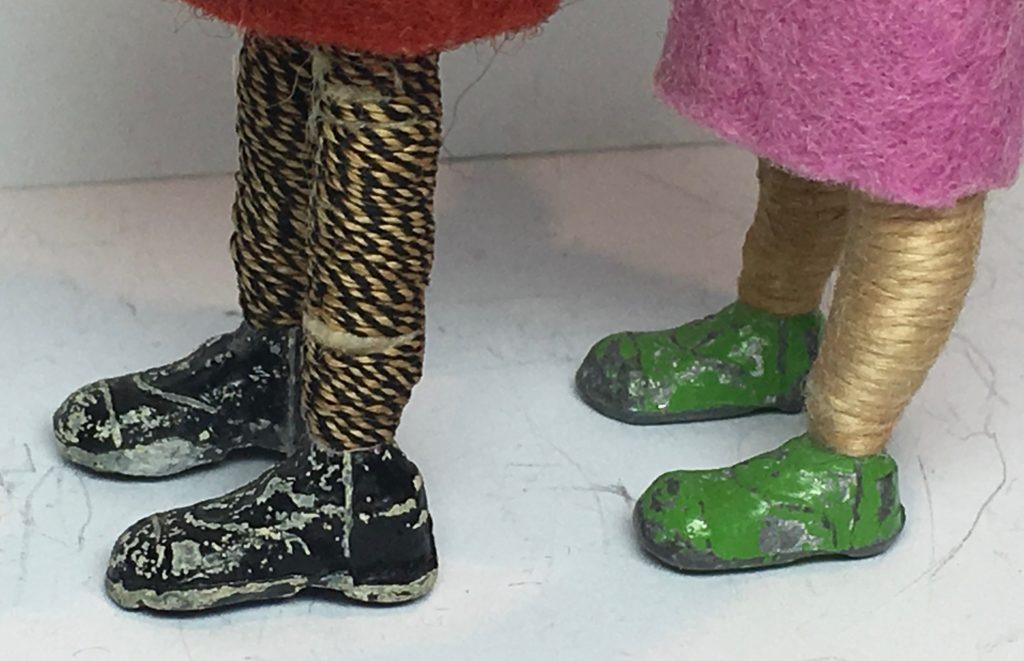
The Small Oxford isn’t as chunky as the earlier Oxford and the back of heel is much less pronounced as can be seen in the above photo. They are, however, still heavy enough to allow the doll to stand well.
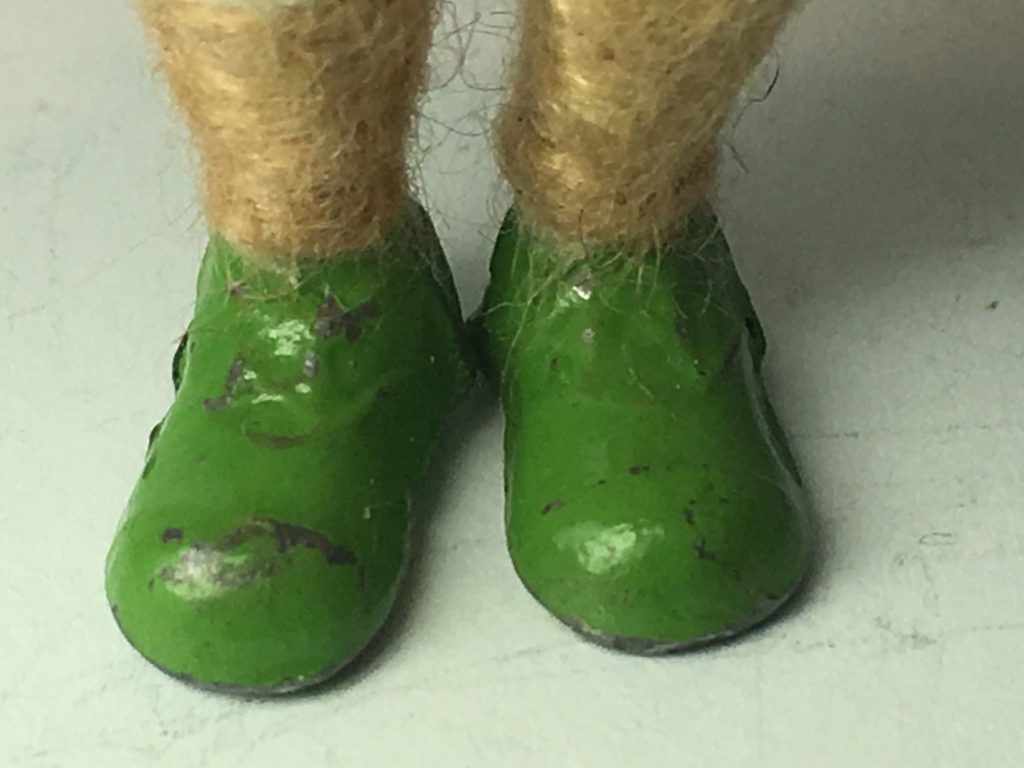
The casting details are lost to an extent on these smaller feet once painted, but I think it’s just about possible to make out the toe seam and a suggestion of laces in the above photo.
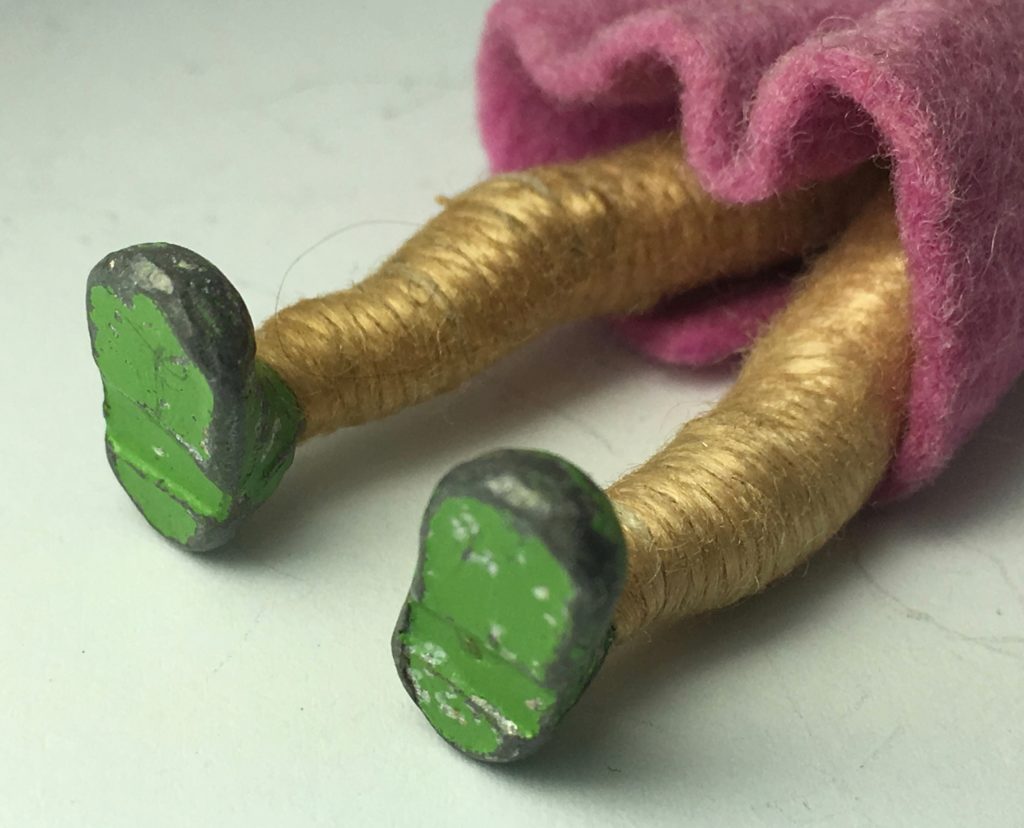
The Small Oxfords still have the indentation in the base to create to create the impression of a heel.
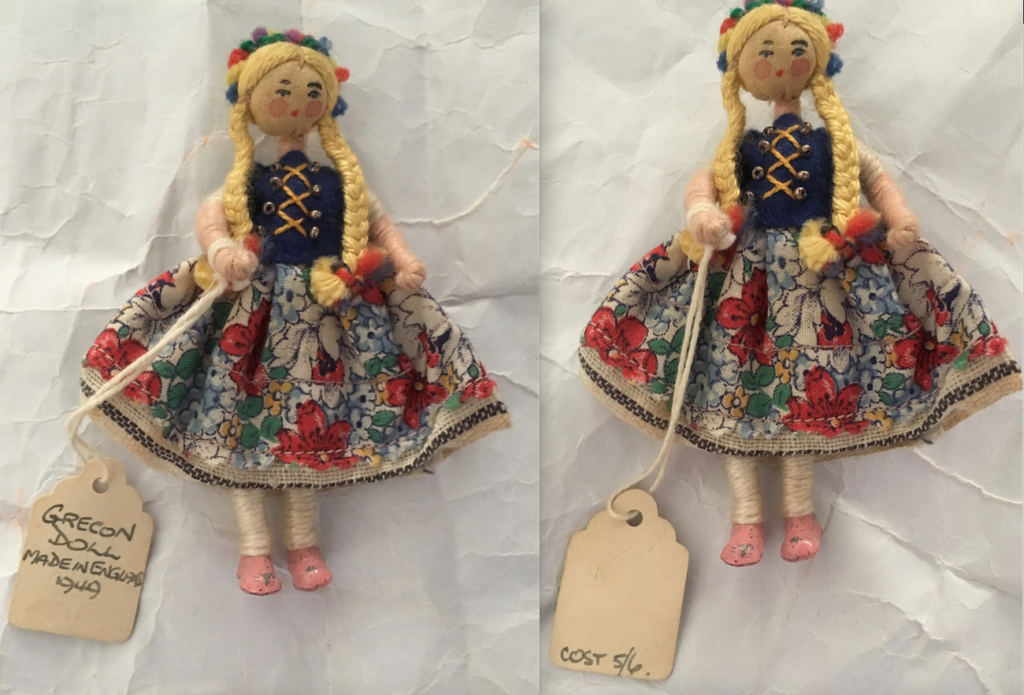
I am inclined to believe that this wrist tag is original to the doll because it does appear to have some age, and I have seen another, earlier (melon-feet) doll with the same tag, but with a different inscription on it (see under ‘Labels’ below). I would be very interested to hear from anyone who has, or who has seen, any Grecons with a similar tag to this one.
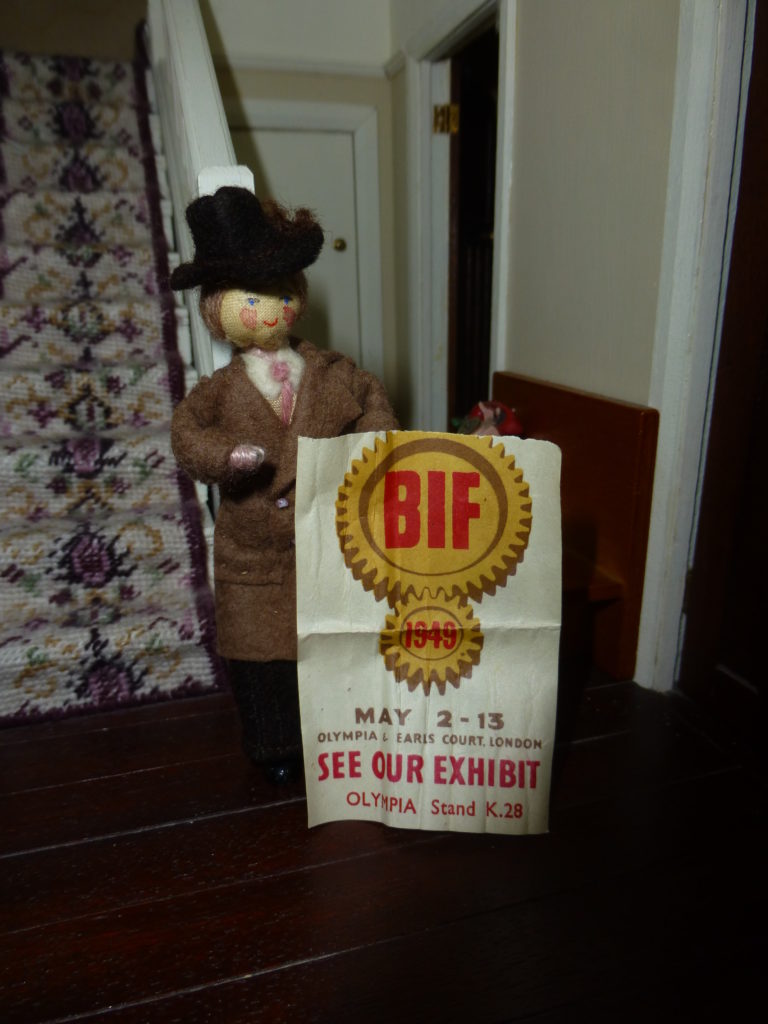
Tucked into his pocket (to look like a rolled up newspaper/magazine) is a little promotional leaflet for the 1949 British Industries Fair. Rosemary Myers also owns a Grecon man with the same leaflet in his pocket.
Of course it’s always possible that left-over leaflets were being used up after the fair had taken place, but it’s surely more likely that they were used in this way to promote the fair either in advance or concurrently. In any case, we can still be certain that we had Small Oxford feet being produced up until 1949.
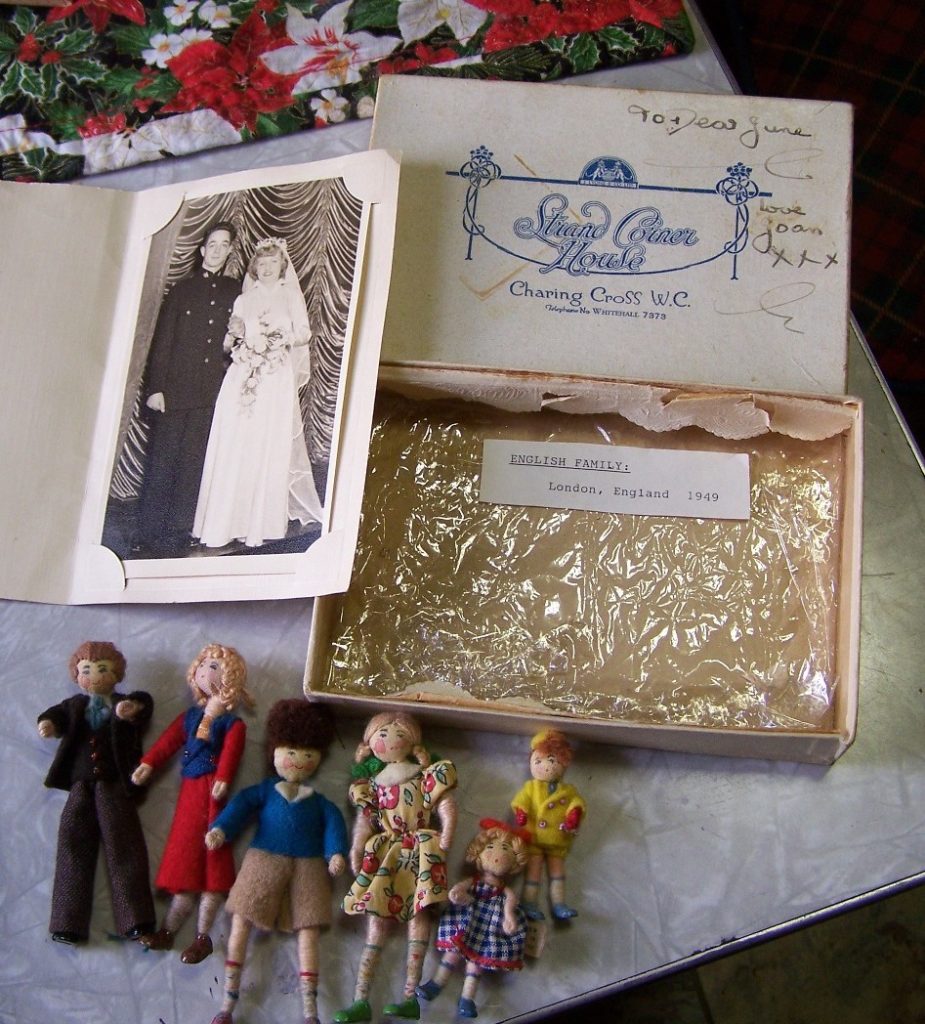
Finally, the Grecons in the above photo belong to a lady in the USA who told me: “The couple who gave them to my mother June, are Keith and Joan Killeen. Joan met mom when mom took a trip to England in the 1940’s just after the war. Joan married Keith and it seems these dolls are a gift Joan sent to mom maybe as a wedding favor?”


The feet are clearly Small Oxfords and the measurements confirm this too.
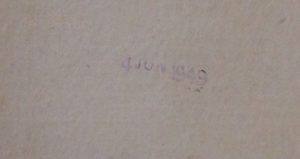
The dolls were sent to June in a box from the Strand Corner House in Charing Cross (one of Lyons’ famous teashops) stamped ‘4 JUN 1949’, however, I haven’t found any evidence to confirm that they were sold in the Corner House and the box might just have been re-purposed. The note sent with the dolls inside the box, however, does confirm the 1949 date.
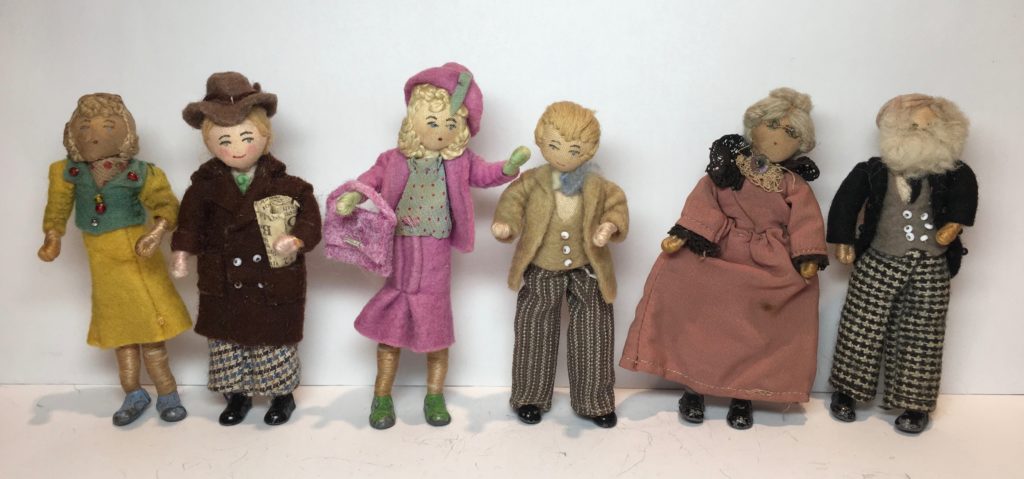
I have quite a lot of these Small Oxford feet dolls and they all have the standard “GRECON MADE IN ENGLAND” label, apart from those where the label has been removed or lost.
4. Peanut Feet (Early 1950s)
Quite early on in the 1950s, the feet changed again. The length and overall width stayed the same 1.3 cm (½”) long and 0.6 cm (¼”) wide, but the foot became much more shapely, with a distinct waist to the sides and top, giving them a sort of peanut (monkey nut) shell dissected-lengthways shape – hence my rather odd name for them. Another way to describe it might be like a clown’s foot but without the excessive length!
The peanut feet should not be confused with the very peanut-shaped (though much larger) feet found on Dol-Toi dolls. Any confusion is very easily cleared up since Dol-Toi dolls have plaster and or plastic heads. Grecons NEVER had plaster or plastic heads.
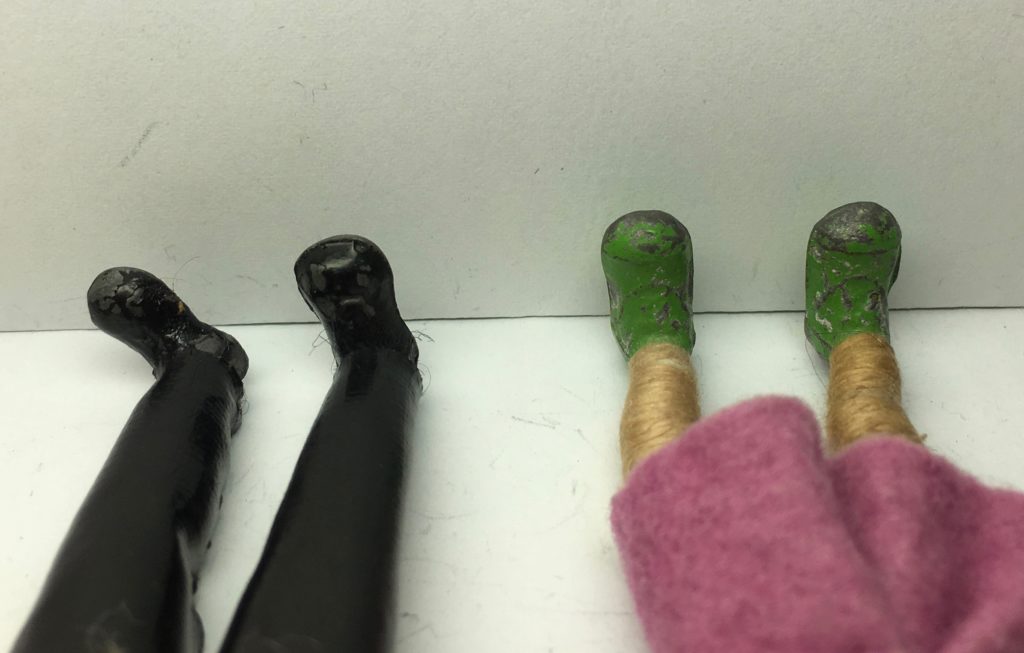
The ‘waist’ on the peanut feet can be seen clearly in the above photo, giving the front of the Guard’s feet a more bulbous look than the small-Oxford feet on the right.
Presumably this was a cost-cutting exercise; shaving a tiny bit more off the amount of lead needed to cast them. It does reduce the weight of them enough to make these dolls less stable on their feet than earlier ones, though they’re certainly not as unstable as those that come after them.
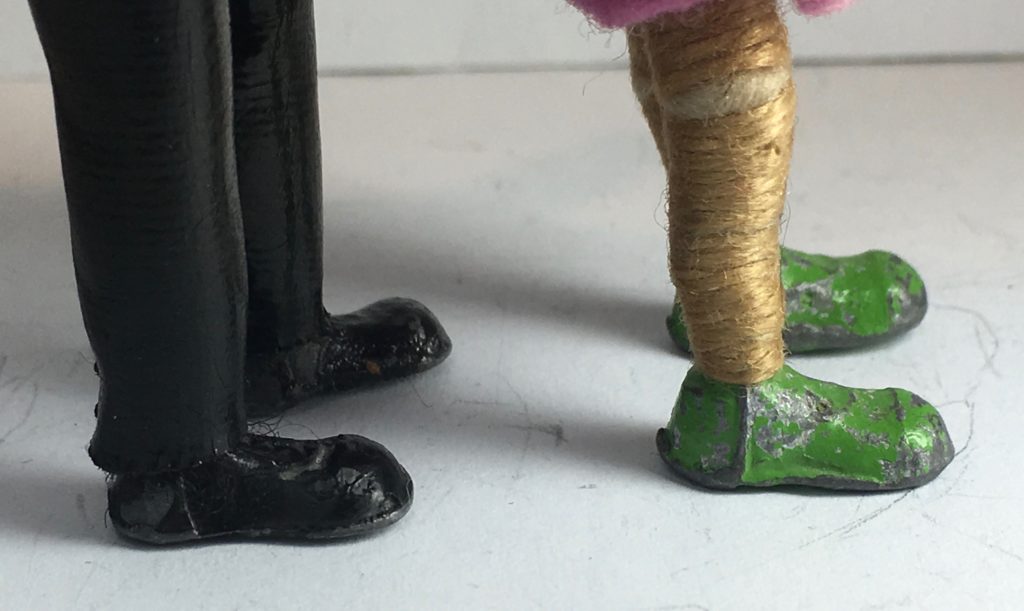
The new mould was obviously plainer, with no toecap seam, though there is still a suggestion of laces and a vertical side-seam on either side of the heel, as seen in the above photo. There is also slightly less depth to the Peanut feet.
There is still an indentation in the base to form a heel.

I can be quite sure that the Peanut feet were introduced early in the 1950s because of my Queen Elizabeth II character which was produced in 1952/1953 to commemorate Her Majesty’s coronation and she has Peanut feet.
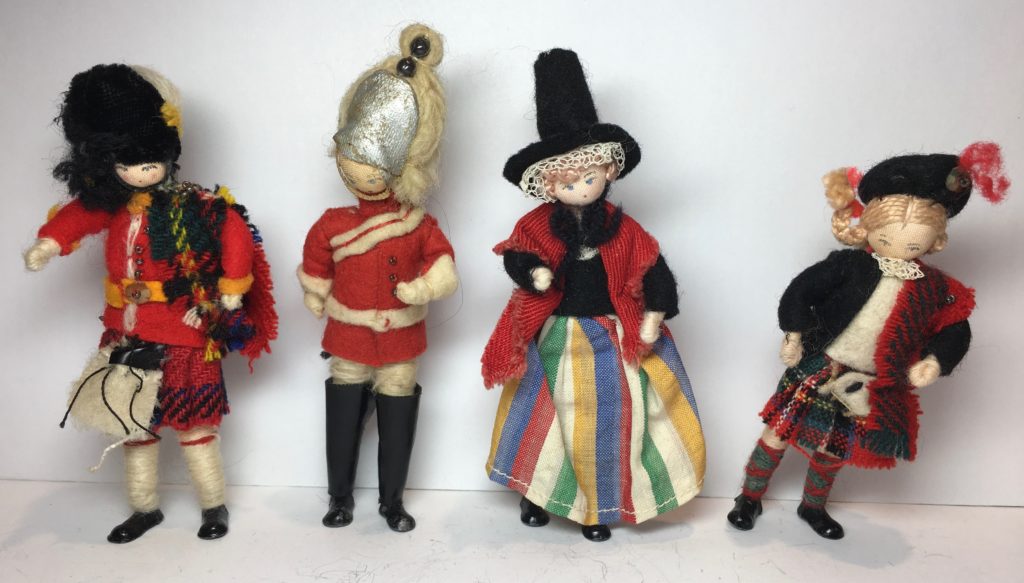
In my experience, the ‘untrained eye can find it difficult to distinguish between the Small Oxford and Peanut feet – the differences I have described above are, after all, only small differences and on very small feet. If the paint is particularly thick or the moulding hasn’t been done particularly well on one or the other, then they can look very similar.
Interestingly, all of the dolls I own with Peanut feet are ‘character’ dolls and not family members, but this might be entirely down to sample-size. Also, out of eight dolls, three have the “GRECON LITTLE PEOPLE” label – this is the first appearance of this label in my collection. The other four have the standard “GRECON MADE IN ENGLAND” label.
5. Flat Peanut Feet (Early-Mid/Late 1950s)
In 1952, A Barton (Toys) Ltd was appointed as the main distributor of Grecon dolls. It’s my feeling, from piecing various bits of information together, that this event might have coincided with a rapid succession of reductions to the weight and size of the feet over the next few years. It makes sense that with Barton taking a slice of the profit margin, Miss Cohn would be looking to reduce costs.
Possibly around 1953/54 (certainly after the production of the Queen Elizabeth II doll in 1952/53), the size of the Peanut feet shrank a tiny bit. Seemingly it was initially only the depth that reduced (hence the term ‘Flat Peanut), but the length seems to have followed suite fairly shortly afterwards.
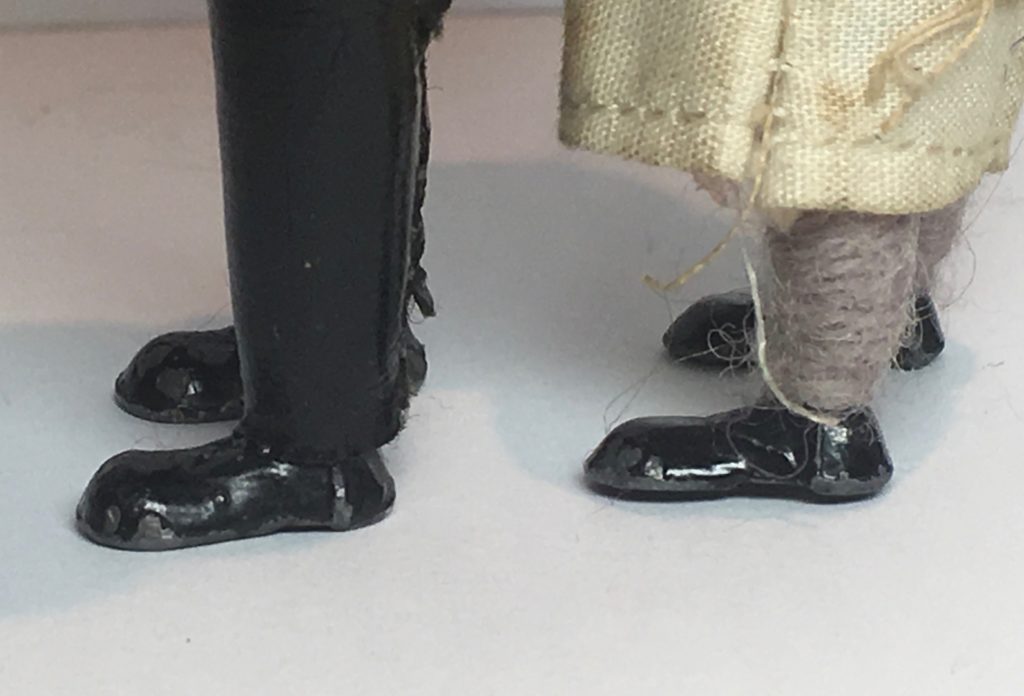
The width stayed the same at 0.6 cm (¼”) but there is a noticeable reduction in the depth of the foot which becomes much flatter – hence the term ‘Flat Peanut’.
These significantly lighter feet heralded the arrival of a period of great instability amongst Grecons – instability that was about to get much worse and was destined to last until their ultimate demise!
In other words, Grecons with Flat Peanut feet do not stand as well as those before them.
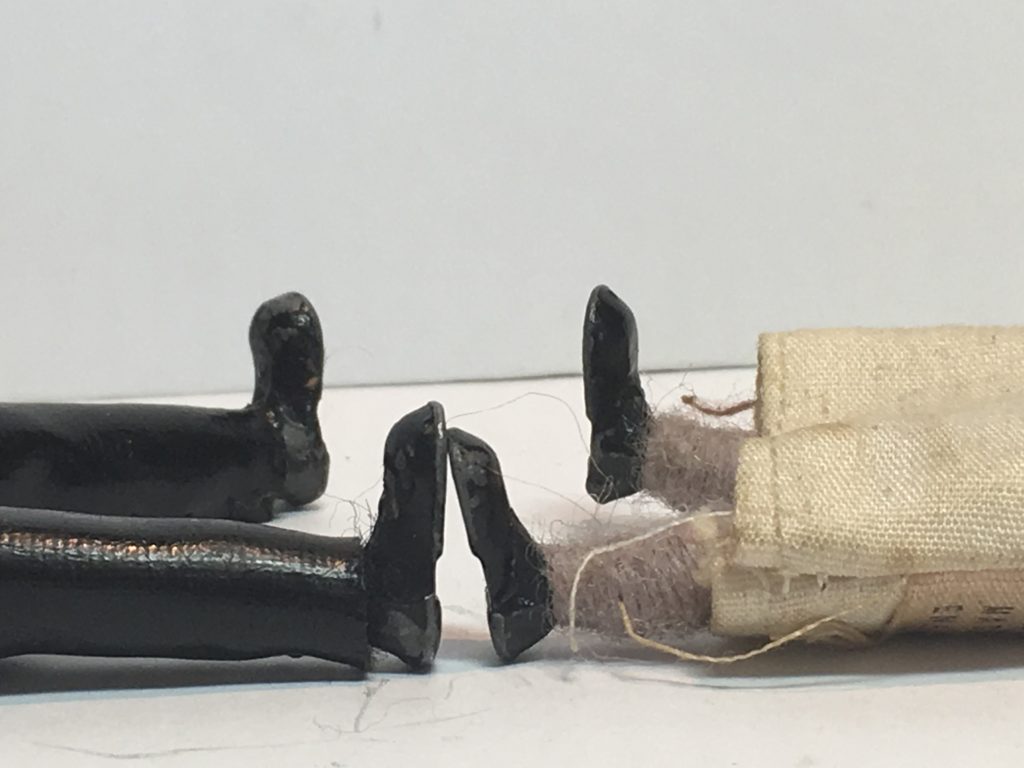
Next, it seems that the length was also reduced, by 0.1 cm, to 1.2 cm (15/32″).
I am assuming that the reduction in depth came first as this would only require the caster to put less lead into the same mould whereas a reduction in length would presumably require a new, smaller mould.
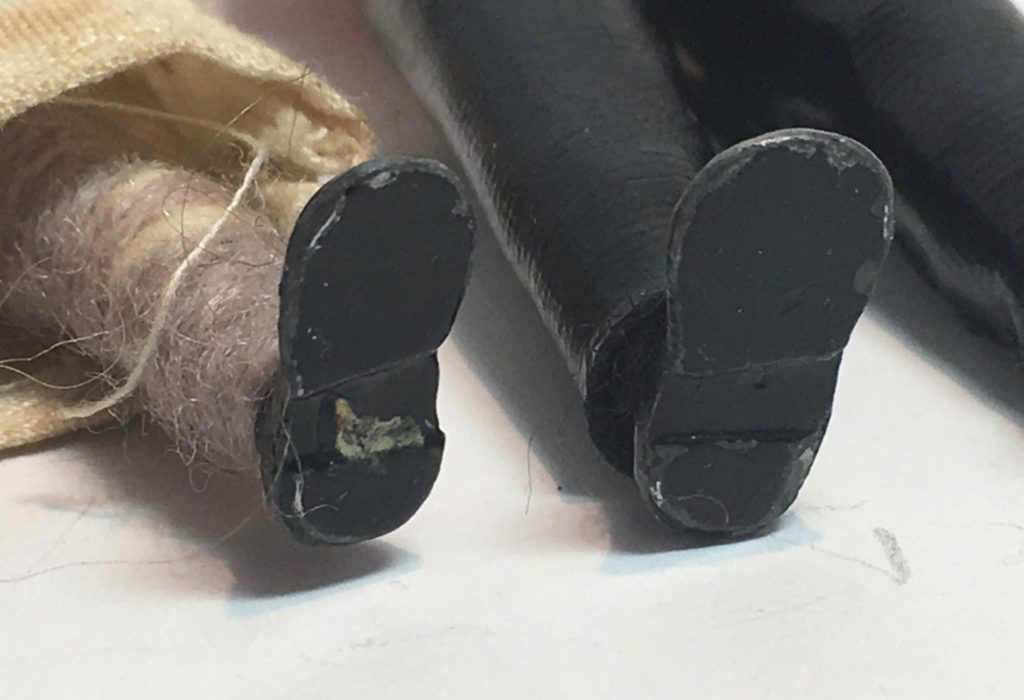
The bases of Flat Peanut feet still have a heel.

Most of this motley lot are leaning against the back wall for support!
Two of my six Flat Peanut feet dolls have the “GRECON LITTLE PEOPLE” label, one has the standard “”GRECON MADE IN ENGLAND label” and the others have either lost their labels or had them removed.
6. Tiny Feet (Late 1950s – Early 1980s)
The next feet, which I am calling Tiny feet, for obvious reasons, seem to have been in production for the longest time, possibly for just over two decades.
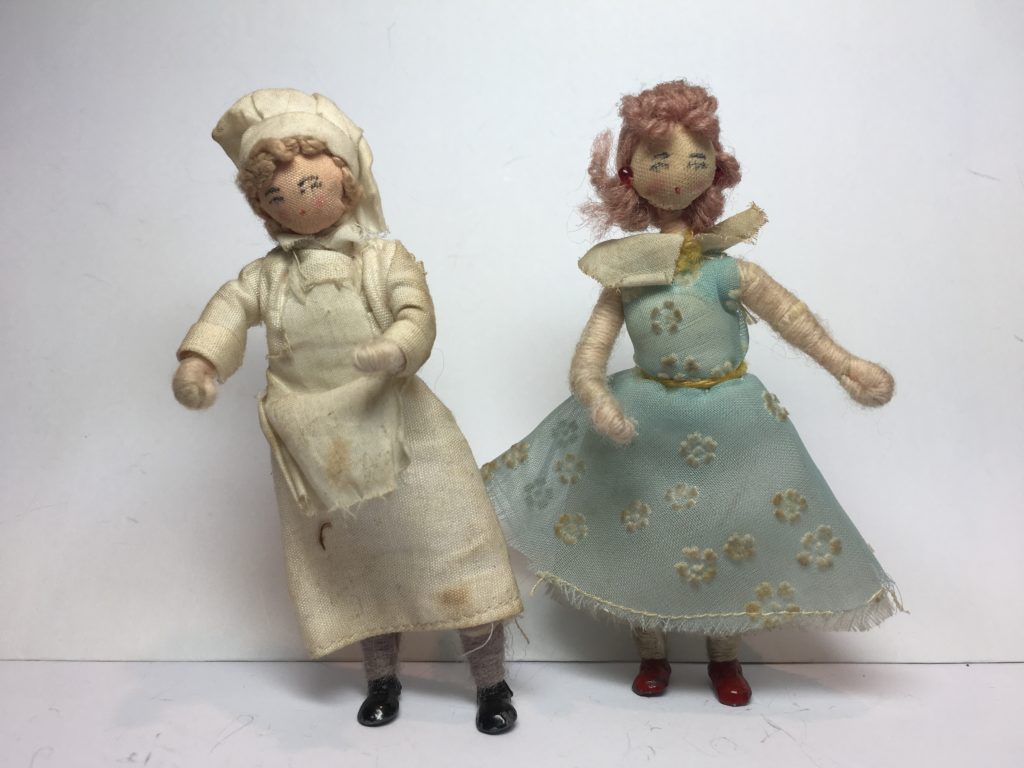
I don’t have any direct evidence of when this foot change took place, other than that it was definitely after 1952/3 (when the QE II character with Peanut feet was produced) and either in or before 1971 (when a Hamley’s catalogue advert shows characters with Tiny feet).
Since the Flat Peanut feet came in between those two events, and since there were a few variations of Flat Peanut feet, I would guess that we must be looking at the Tiny feet being introduced sometime in the late-1950s.
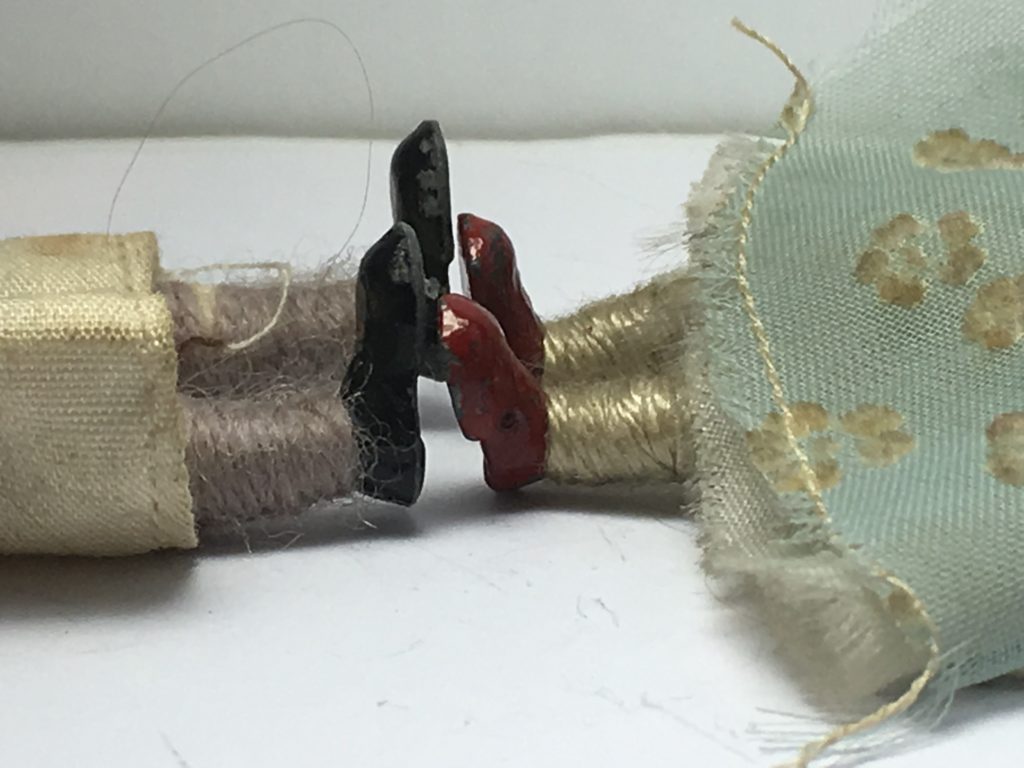
Tiny feet are only 1 cm (3/8″) long. A reduction of 0.2 cm (1/16″) on the Flat Peanut. The width was also reduced by a further 0.1 cm to 0.5 cm (3/16″) but the depth is roughly the same.
There is still an indentation in the base to denote a heel. The indent is quite indistinct on some of the later Tiny feet dolls I own but it is still present.
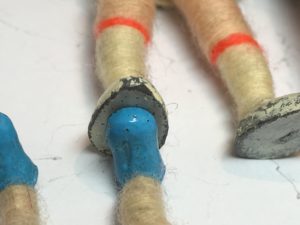
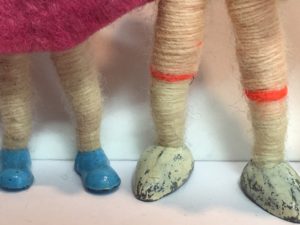
Tiny feet are a whopping 0.5 cm (3/16″) shorter and 0.4 cm narrower than the original Melon feet that Miss Cohn started out with in the 1930s!

Since Tiny feet are so much smaller and lighter and the move to their use seems to have coincided with a disregard for even leg-length, these characters are are extremely difficult to stand upright unaided – the characters in the photo above are nearly all relying on the wall behind them or each other for support.
As Rosemary Myers pointed out: “Grecons need big feet to go about their daily fun without toppling over. The older dolls with bigger feet have lasted longer because their limbs are not constantly being moved to give them balance.”
And true enough, there is a definite trend toward scruffiness amongst my later Grecons, which is the exact opposite of what you would ordinarily expect to find.
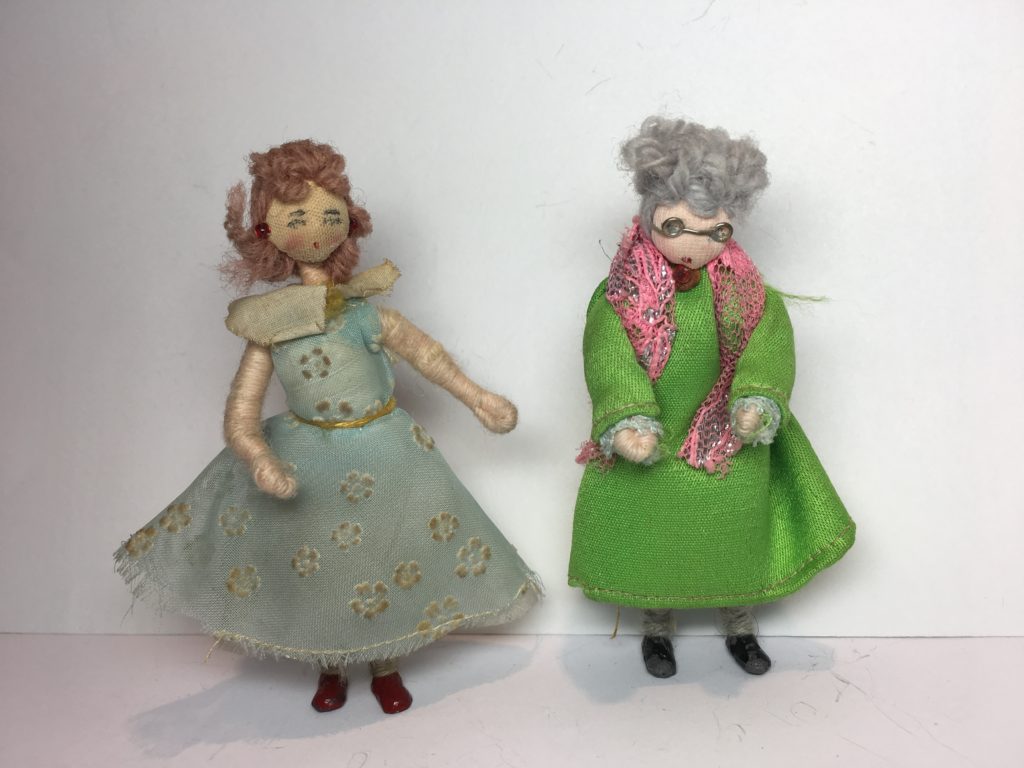
I am a little short on any factual evidence here, but Tiny feet seem to have been used, without change, from [probably] the late-50s right through to [possibly] the beginning of the 1980s. If there are any slight variations, they are as likely to be down to the finishing (the edges were trimmed with a knife after casting) as anything else.
I believe that the lady on the left above is my earliest Tiny feet character, based on the similarity of her face-painting to other Flat Peanut feet characters, and the fact that she has the same ‘GRECON LITTLE PEOPLE’ label, as several of my Peanut and Flat Peanut feet characters do. I think that the granny on the right in the photo is my latest Tiny feet Grecon: her nylon clothing would seem to suggest that she’s a later character. While I am not at all certain of her date, I would guess at about 1980, simply because that is when I think the next and final foot might have come into use.
At the time of writing, I have twenty four Tiny feet characters and only one (the lady on the left above) has a ‘GRECON LITTLE PEOPLE’ label. Seventeen have the ‘GRECON MADE IN ENGLAND’ label and six have lost or had their labels removed.
7. Casting-line Feet (Early 1980s – 1986)
In the very final phase of Grecon production the feet appear to have been cast in a mould with a distinct join running around the centre of it. This gave the feet a distinct casting line which runs all of the way down the centre of the foot on both the upper part and the base [see photo below] – hence the name I have given to them.
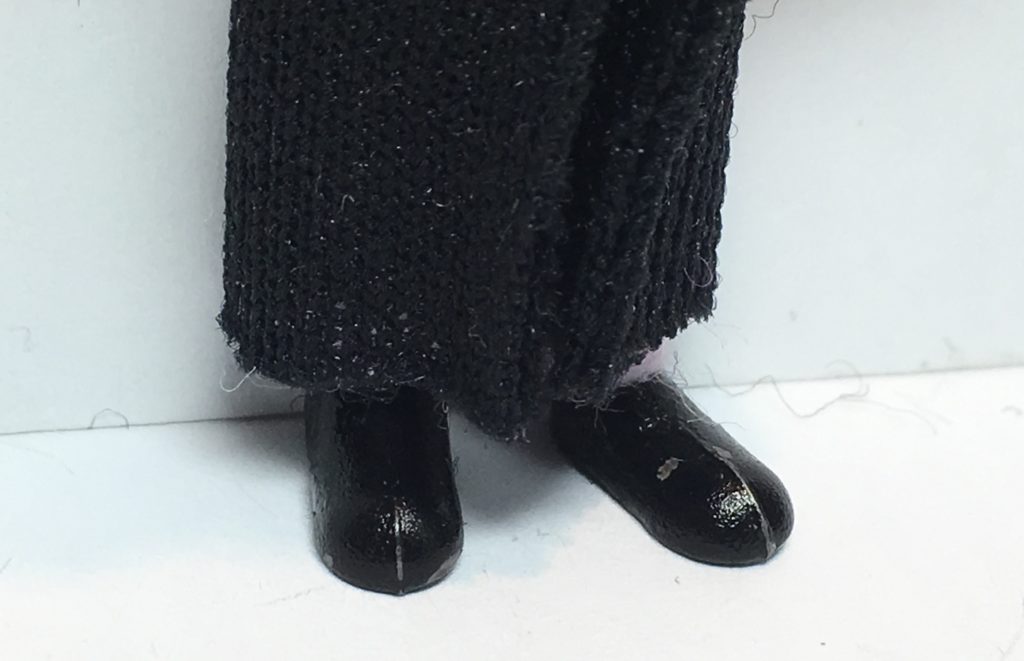
Bucking the trend for shrinking feet, adult Casting-line feet measure 1.1 cm in length and so are 0.1 cm longer than Tiny feet. However the width shrinks by 0.1 cm to 0.4 cm, with the depth staying roughly the same
The Casting-line foot is slightly contoured on the top to indicate a toecap, but the sides are quite straight with the ‘waist’ – seen to a greater or lesser degree on all of the earlier versions apart from Melon feet – having disappeared.
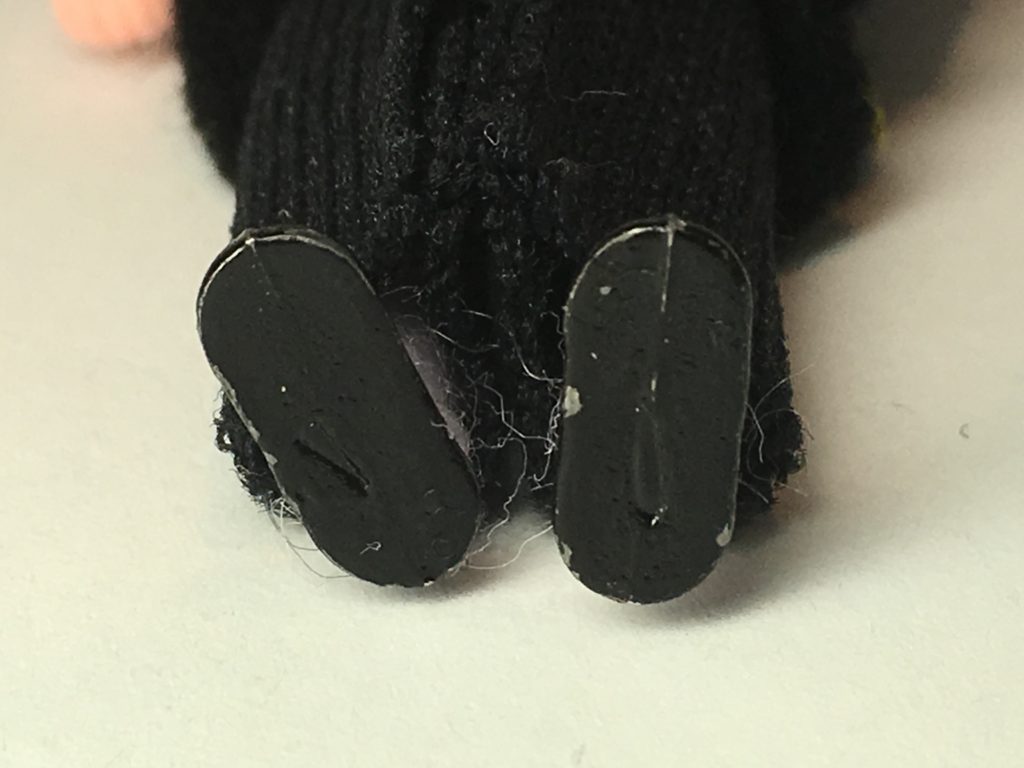
The bases of Casting-line feet are flat with no indentation to indicate a heel. The casting line continues across the base of the feet and the bent ends of the leg wires can usually be seen, embedded in the feet.
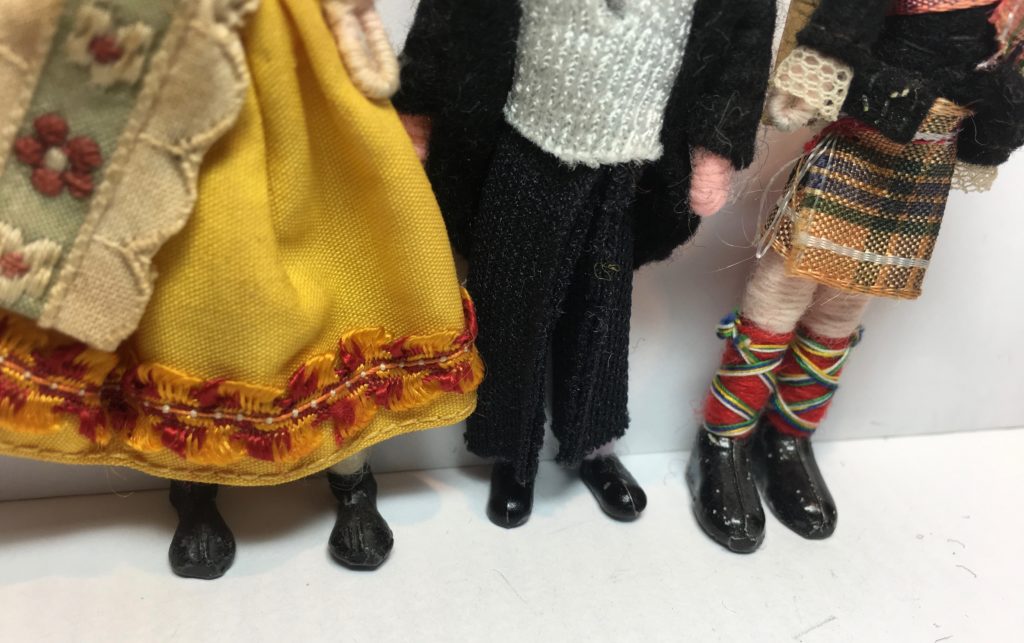
The Casting-line feet Grecons should not to be confused with Dol-Toi and Tomac dolls’ house dolls which also have casting lines down the centre of their feet.
Telling them apart is actually very easy because, as the above photo shows, at only 0.4 cm long, the Grecon Casting-line feet are dwarfed by the bulbous 1.4 cm long Dol-Toi feet and the very sturdy 1.6 cm long Tomac feet. There may (or may not) have been variations in Dol-Toi and Tomac feet over the years but I have never seen any that are anywhere near as short or insubstantial as the Casting-line Grecon feet.
Also, unlike on Grecons, the casting line on Dol-Toi and Tomac feet does NOT continue across the base of the foot.
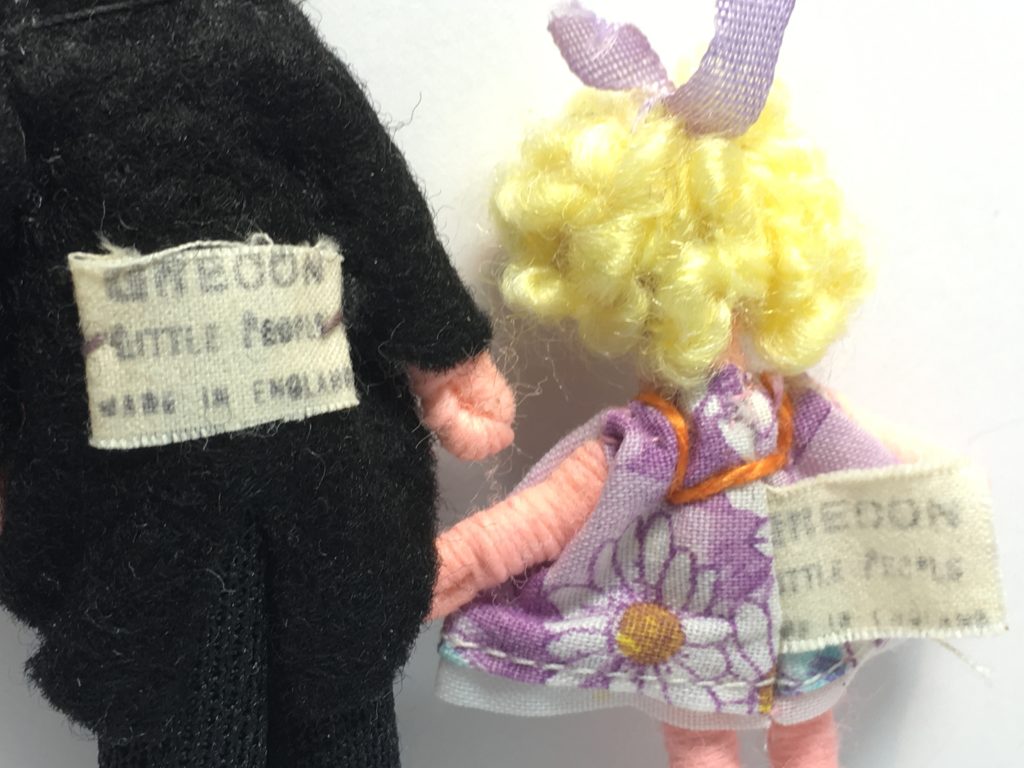
Again, I am short of direct evidence to date these feet, but my guess that they were produced from the early 1980s onward is based on the fact that they only appear on the very latest dolls (as evidenced by their labels, face-painting and clothing), examples of which I know to have been purchased by fellow collectors, brand new, in the early-mid 1980s.
This would also fit, time-wise, with when Grecons ceased to be sold in Hamleys in the early 1980s. After that, Grecons could be bought directly from Miss Cohn herself, or purchased from Mrs Hazel Baldwin’s shop in Chichester (though there might well have been other outlets that I’m not aware of).
At the time of writing, I have six of these Casting-line feet characters (two adults and four toddlers) and all six of them have the later ‘GRECON LITTLE PEOPLE MADE IN ENGLAND’ label seen in the above photo.
Part II – Children’s Feet
1. Melon Feet (1930s – early 1940s)
As mentioned above under ‘Adult Feet’, the earliest feet are a distinctive ‘melon’ shape.

As you can see from the above photo, the same size Melon feet were used for both adults and children. These early ones measure 1.5 cm (⅝”) long and 0.9 cm (⅜”) wide.
Later, non-melon footed children generally had smaller feet than the adults.

Again as mentioned above under ‘Adult Feet’, by the 1940s, Melon feet appear to have reduced slightly in size. Amongst the examples I have, just over 0.16 cm (1/16”) has been shaved off the length, and the depth of the foot is reduced too – most likely to save on lead at a time when it would be increasingly difficult and expensive to come by.
In the photo above, the early button-head soldier on the left (late 30s/very early 1940s) has full-size Melon feet, however, the other, soft-head, characters in the line-up (early 1940s) have the slightly shorter ones and these reduce in depth from left to right until the dusty little lady on the far right has very flat feet indeed.
2. Mary Jane Feet (Children. Mid 1940s)
At the same time that adults were of the ‘Oxford Feet’ variety, the children seem to have been given Mary Janes. The term ‘Mary Jane feet’ refers to the detailing of the casting, which emulates Mary Janes – a very popular style of children’s footwear throughout he first half of the 20th Century.
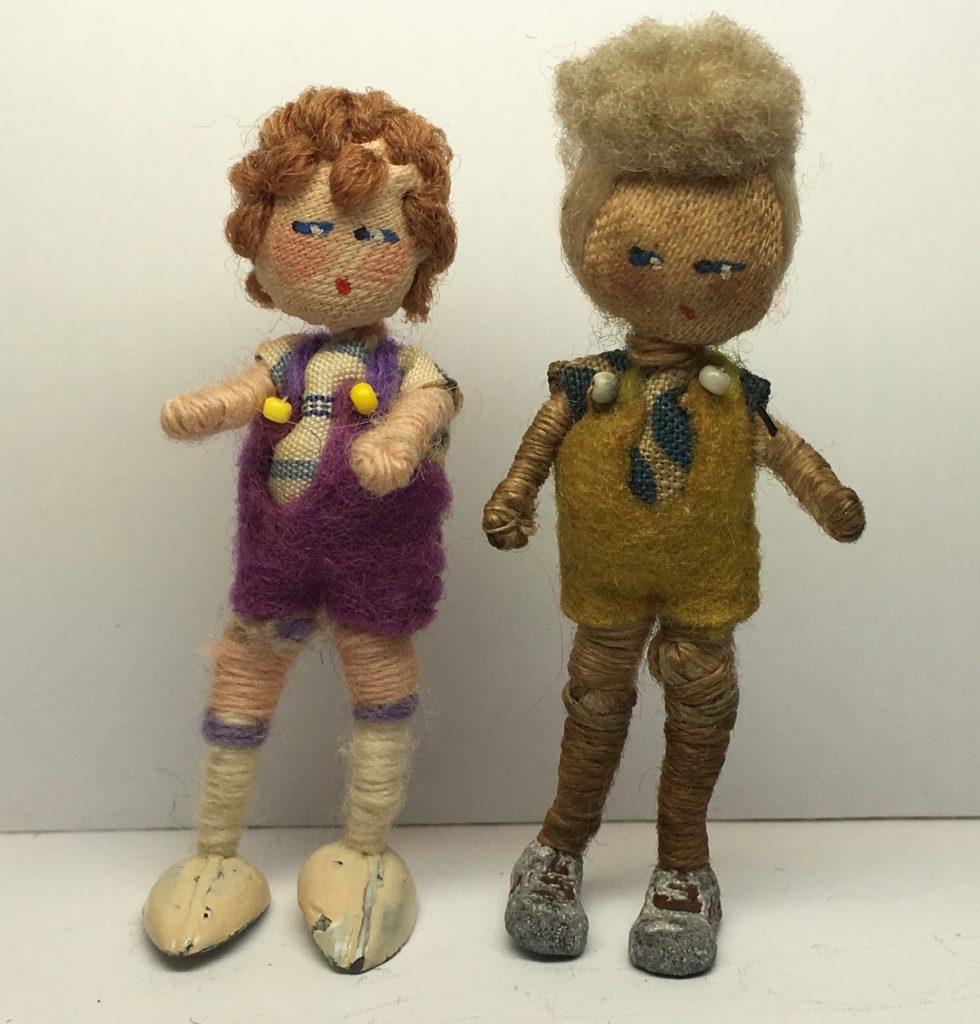
The photo above shows a [very grubby] example of a toddler with Mary Jane feet and it is his similarity to the boy to his left with Melon feet that leads me to believe that the Mary Janes followed on from the Melons.
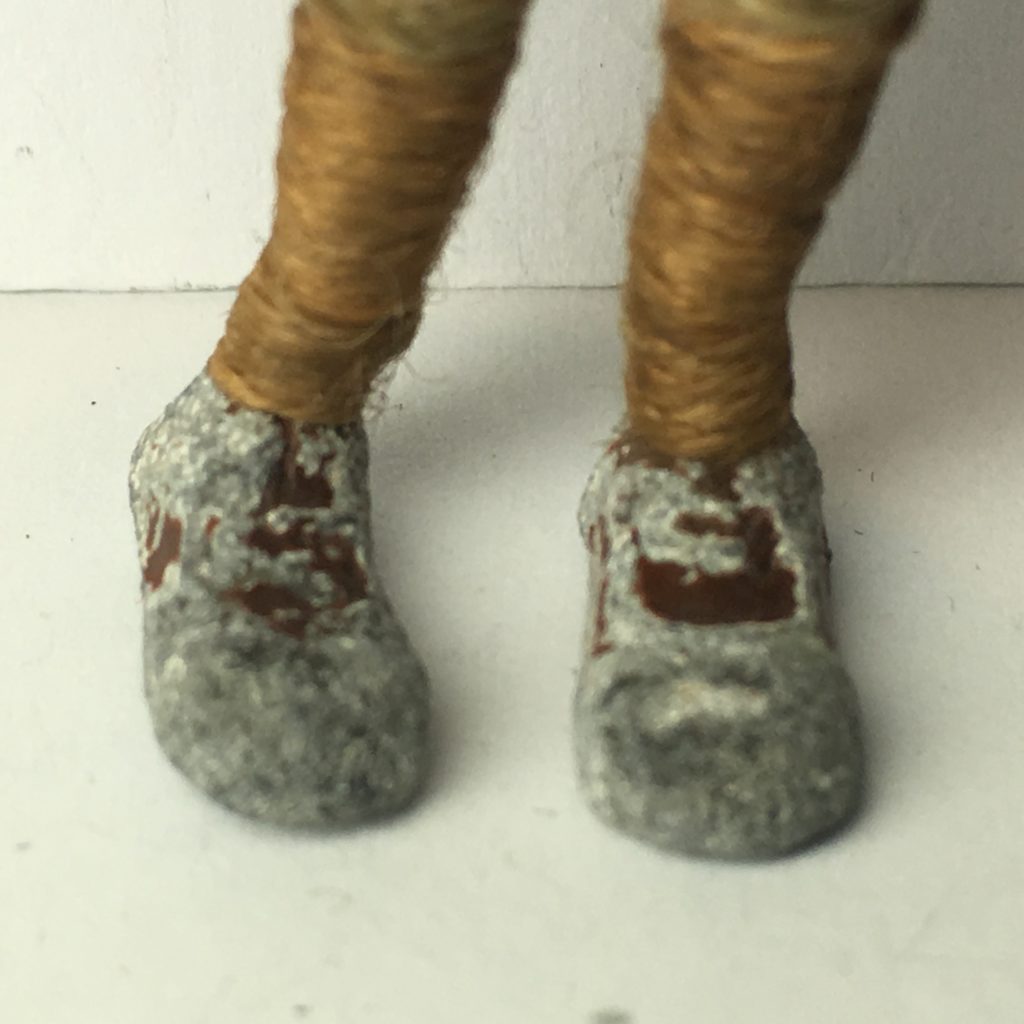
Unfortunately, my boy’s feet seem to have suffered from a bit of corrosion but the Mary Jane details are just about distinguishable – the wide, rounded toe, the scooped out front and the strap just below the ankle. Mary Jane feet are quite chunky, measuring 1.1 cm (7/16”) long and 0.6 cm (3/16”) wide.
This section is to be continued – children’s feet still to be completed…
Labels
Pre-1936 (when Miss Cohn lived in and traded from Germany)
Miss Cohn stated in a letter to a retailer, that she started producing dolls in about 1925. However, I’ve seen no evidence of the style of doll that we know and love as Grecon dolls existing pre-1936: the earliest labelled example I’ve seen is stamped “Made in England” and was, therefore, certainly made post-1936. Additionally, the extensive and largely pre-1936 Grete Cohn collection I viewed in 2018 (and now own a part of) contained no evidence of them either.
Perhaps Miss Cohn was referring to little wool-wrapped figures in general (and the archive referred to above certainly contains many of those) and not necessarily the type that she became most well-known for. Or, perhaps they’re out there somewhere, still waiting to be discovered!
There were, however, markings/stamps on some of the items she produced pre-1936 and here are some examples:
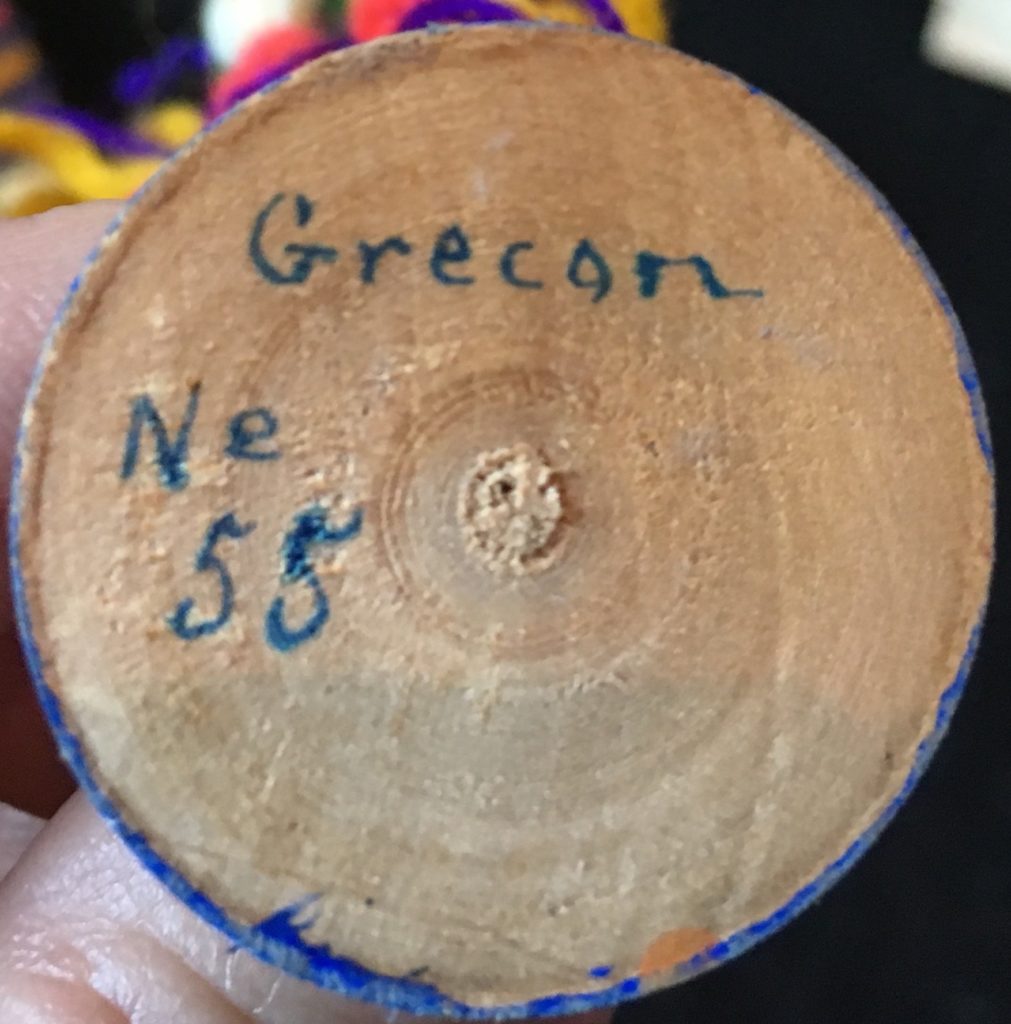
This mark is on the wooden base of an artistic wool and wire figure. The fact that it is hand-written, has a low number on it and does not refer to the trademark as being registered, suggests that it could be a very early piece, probably from the 1920s.
[The pedantic side of my brain forces me to mention the possibility that Miss Cohn might also have re-started her numbering when she came to England and that this could be an early piece from the late 1930s as we know that, initially at least, she produced a variety of “artistic toys and artistic novelties” in England too and there is nothing to pin this down to Germany with absolute certainty.]

This stamp is on the wooden base of a little pipe-cleaner animal (a bear, I seem to recall). The acronym D.R.G.M. stands for Deutsches Reichsgebrauchsmuster, meaning that the design was officially registered inside all of the states within Germany.
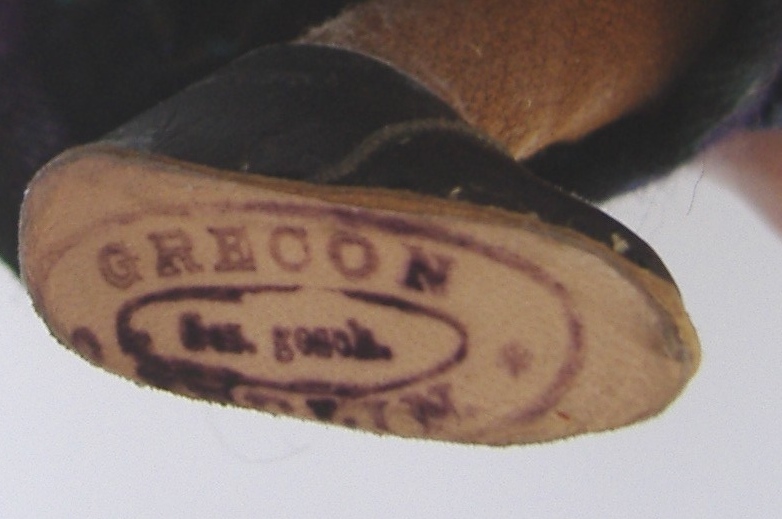
This oval stamp is on the sole of the shoe belonging to a large (approx. 30 cm or 1′ tall) doll made from leather and fabric. It says GRECON BERLIN in the outer oval and “Ges. gesch.” on the inside – an abbreviation of “Gesetzlich Geschutzt” which translates literally as ‘legally protected’.
The large [largely] pre-WWII collection I viewed also contained a little cloth doll with the initials ‘G.S.’ carefully stitched onto her under-skirt.
I have never seen any of these marks outside of the archive mentioned above and I would love to hear from anyone who has any items bearing them.
Post-1936 (when Miss Cohn lived in and traded from England)
The vast majority of Melon feet Grecons seem to have been produced without labels.
In my own collection, only four of my early dolls have a label of some sort and they are not of the type generally associated with Grecons.
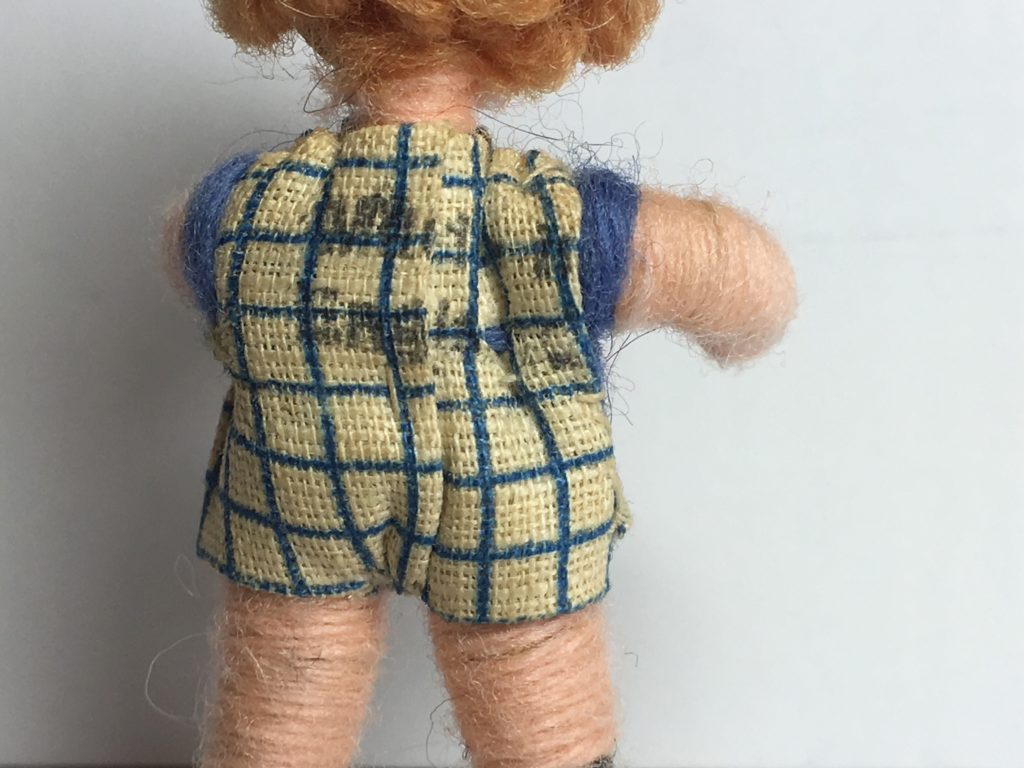
I have this late-1930s Melon feet boy who has ‘Made in England’ stamped directly onto the back of his little play suit in ink.

I also have this late-1930s Melon feet maid/nursemaid with the same ink stamp on the underside of her felt apron. These are the only two examples of this stamp that I’ve seen.
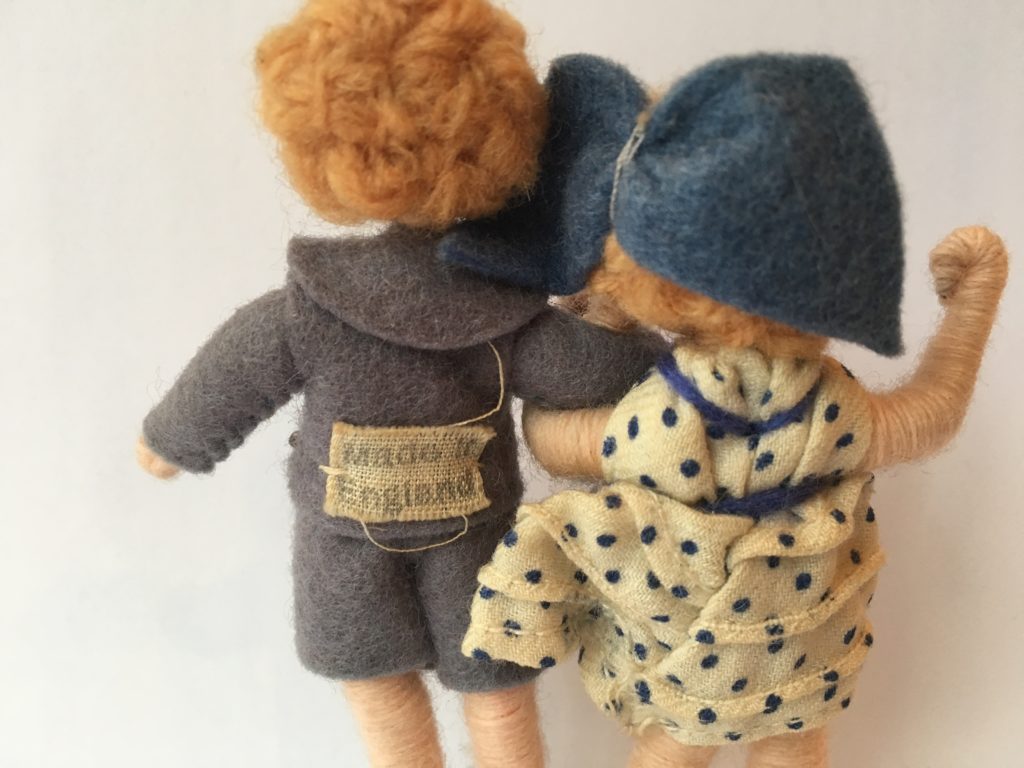
Then, I have this 1930s Melon feet pair where the boy has a ‘Made in England’, in upper and lower case, stamped onto a label in ink and sewn onto the back of his jacket. Again, I haven’t seen any other examples of this label.
It’s possible that these dolls are from a period when Miss Cohn was experimenting with the idea of labelling: firstly trying a stamp directly onto the doll’s clothing – perhaps not deemed to be very satisfactory since stamping onto the soft surface of the doll wouldn’t produce a good print; then trying with a stamp onto fabric to be attached to the doll – much more satisfactory since the fabric could be placed onto a hard surface for printing which would be much more sucessful.
Another theory, since all three of the above dolls were bought from the USA and the label focuses on the ‘Made in England’ aspect rather than the Gecon brand, is that it was because the dolls were destined for the export market that Miss Cohn was keen to label as being made in England.
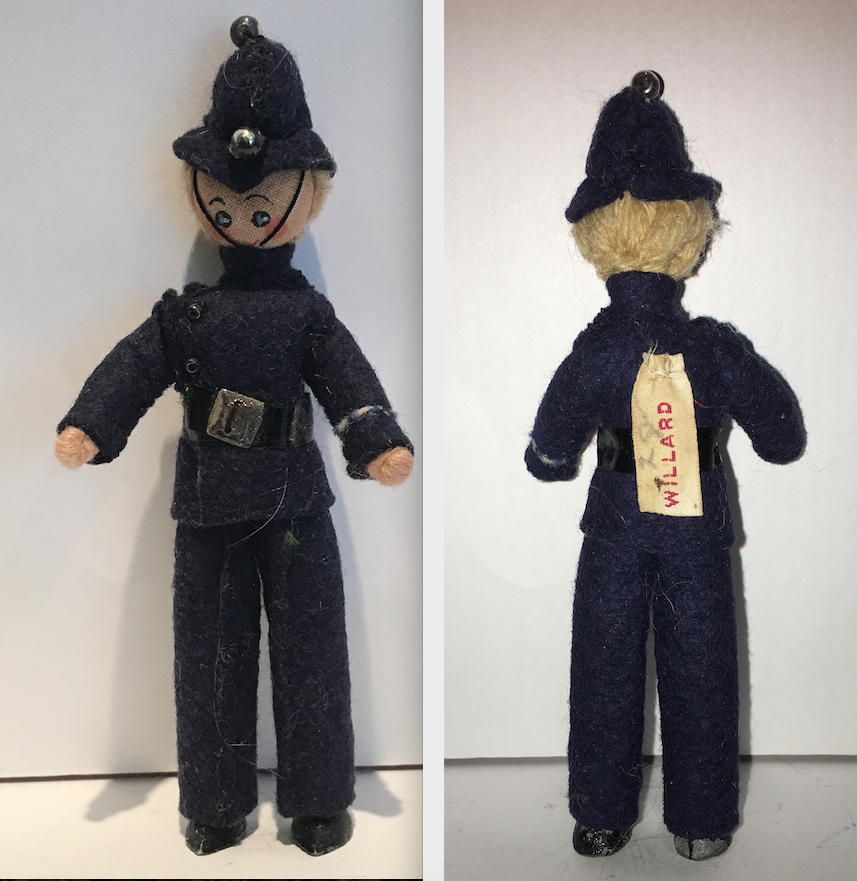
This British Bobby (policeman) was repatriated to the UK from the USA and arrived to reveal an unexpected label. I can only assume that Ms. Cohn decided to give him the name Willard. I’m told that this is a Cash’s label (machine sewn) and that it’s therefore likely that there were several produced with the same name. I would be very interested to hear from anyone who has, or who has seen, a Grecon doll with the same label, or similar.
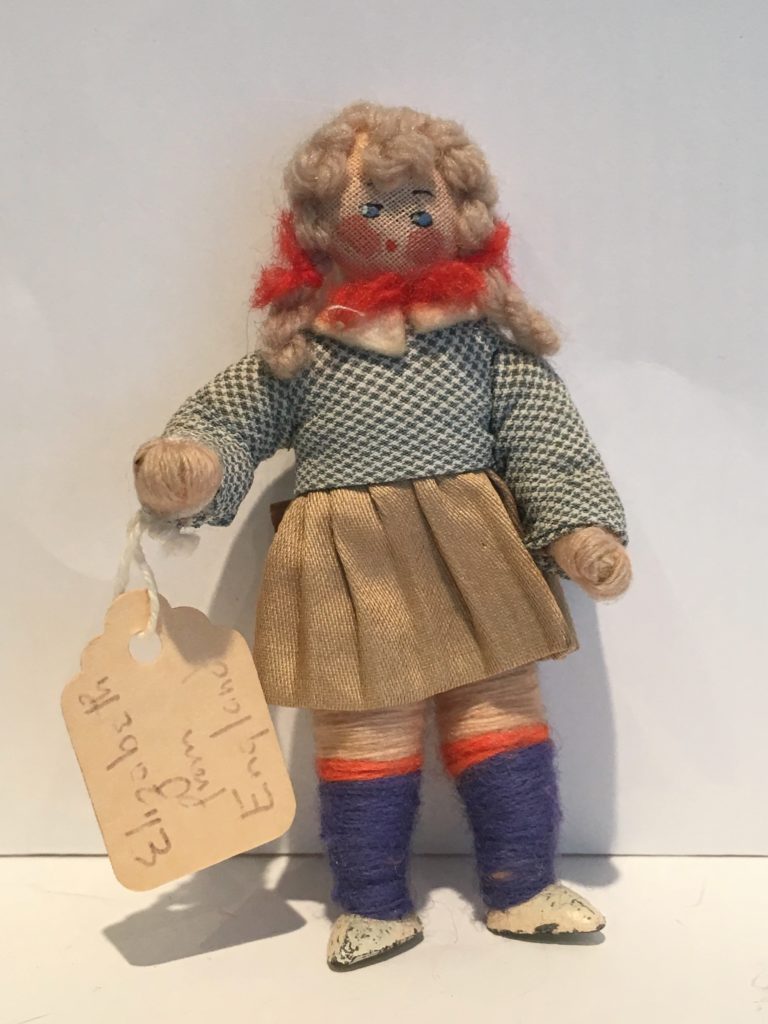
The melon-feet girl above (with very chunky legs!) doesn’t have a Grecon label (and, as mentioned above, most characters of this age don’t) but she does have a tag around her wrist which names her as “Elizabeth from England”. Again, I would be very interested to hear from anyone who has, or who has seen, a Grecon doll with the same label, or similar.
I am inclined to believe that this wrist tag is original to the doll because:
- it does appear to have some age,
- I have seen another, slightly later doll with the same size and shape of tag but with a different inscription on it (see under ‘Feet’ above), and
- because it is written in the same distinctive handwriting as that on the tag in the next photo below.

The 1:12 scale couple shown above are early melon-footed characters a tag attached reading “A devoted Russian couple” – they are so devoted that they are physically attached to each other! As mentioned above, the handwriting on the tag is very similar to that seen on the tag attached to the wrist of the girl in the previous photo, suggesting that both are original.
[Since receiving this photo from Lynne, I have been lucky enough to acquire a “devoted Russian couple of my own! Mine couple doesn’t have a tag and they are holding hands rather than the man having his arm around the lady’s shoulder. It’s great to know, thank’s to Lynne’s photo, the country that the traditional costumes were made to represent as it’s not always possible to identify that with certainty.]
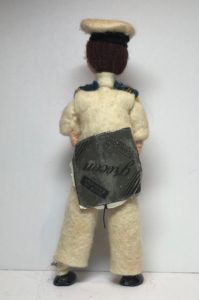
Next I have an early-1940s, character with Melon feet who has a paper label stitched to his jacket that reads ‘Made in England Grecon London’.
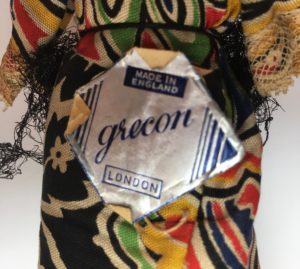
The label can be seen more clearly on this 1:12 scale 1940s granny who has Oxford feet.

This is the reverse of the paper label. Both of the Grecon dolls I have with this paper label were bought by me from the USA and, given the very patriotic look of the label, I again wonder if it was produced specifically for dolls destined for export, perhaps just after WWII.
My friend and fellow-collector, Rosemary Myers, has a theory about these paper labels which I think makes perfect sense. She suggests that Harrods or Hamleys might have had them printed because of the colour-work involved in the union jack which would have been quite costly. It seems unlikely that Miss Cohn would have gone to this expense herself and so Rosemary suggests that one of the larger retailers, possibly Harrods, would have had them printed as part of a promotion. This also applies to the silver effect on the labels which, again, would have been an expensive cost for Miss Cohn’s small business to bear, especially since she was selling them at trade price.
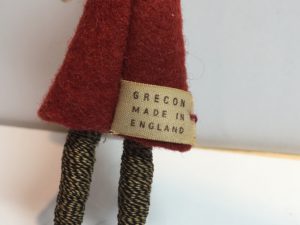
Now we get into more familiar territory. This is upper case ‘Grecon Made in England’ label most commonly seen. Following the introduction of this label it would seem that all Grecons were produced with a label and where they’re found without one, it’s likely that it has been subsequently removed.
The lettering is printed onto fabric and here it is stitched to a mid-to late 1940s maid with Oxford feet. This label seems to have been used, with only very slight changes in the fabric used, for several decades from the mid-1940s right up until the early 1980s.
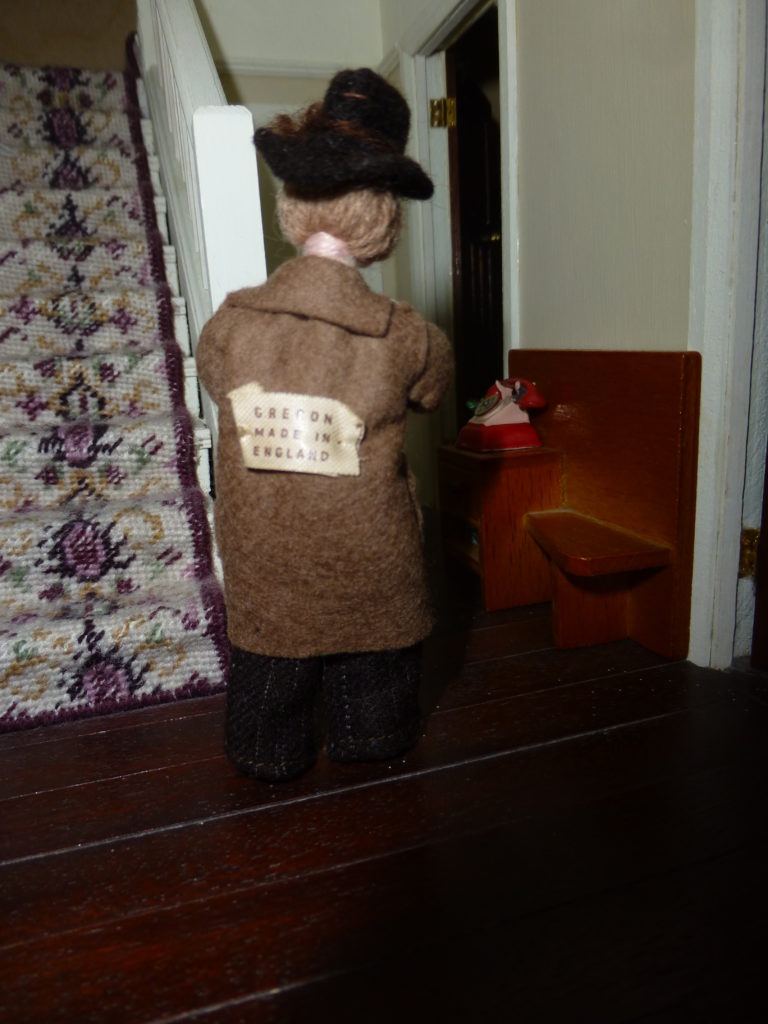
The label was either sewn into a seam in the dolls’ outfit or attached with a few stitches (or both), usually in plain view on the back, though I have see one example of a man with his label situated underneath his jacket.
Here it is (above) stitched to the back of a chap who can probably be dated fairly specifically to 1949 because of a leaflet, rolled up in his pocket to look like he’s carrying a newspaper, advertising the British Industries Fair held in May of that year (see photos under ‘Oxford Feet’ above).
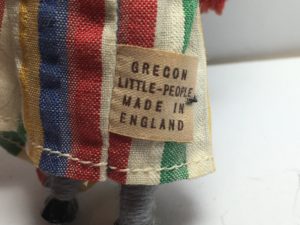
Slightly less common is this label which seems to have been used contemporaneously, for a while at least, with the previous label. It is still printed on fabric in upper case but this time it reads ‘Grecon Little-People Made in England’.
This label is not to be confused with the later ‘Little People’ label which has the same wording, but the typeface used was different: on the later version, the font size of the upper case letters reduces with each line of the label. Also, whereas the words ‘Little-People’ are hyphenated on this label, this is not the case on the later version.
From what I’ve seen, this label seems to have first appeared in the 1950s, a little later than the previous one shown. I have examples of it on dolls with Peanut feet (early 1950s), Flat Peanut feet (early-mid/late 1950s) and on one character with Tiny feet but dating to the late 1950s.
I don’t have this label on any characters that I would date to later than the 1950s, though that’s not to say that they don’t exist and I’d be very interested to hear from anyone who might have one.

It’s logical that the ‘Little-People’ label was used for some particular purpose – maybe export, maybe for a particular outlet or distributer – but I haven’t [yet!] been able to determine what it was.
In terms of dating when these label were first introduced, these two ladies were clearly made around the same time – probably in the early 1950s – but the lady in pink (with refurbished legs) has a standard ‘Grecon Made in England’ label and the lady in blue has a ‘Grecon Little-People Made in England’ label, which could indicate that this is when these ‘Little People’ labels were first introduced.
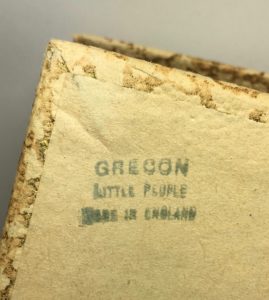
Also, the stamp seen above is on the original box of my Grecon Queen Elizabeth II doll, which was produced in 1952/3 to commemorate the Queen’s coronation in 1952. The presence of the ‘Little People’ reference on this is an indication that the label bearing the same words was probably used from at least this date.
Interestingly, the stamp on my Queen’s coronation character box is exactly the same as the printing on the later ‘Little People’ label in both size and style (see photo below), even down to the missing hyphen, and I wonder, therefore, whether the same stamp was brought into operation again to make the final, more home-made/amateur-looking label seen in the 1980s.

The final label, as far as I’m aware, seems to have been used from the early 1980s up until Grecon production ceased in 1986, and saw a return to the use of the term ‘Little People’.
This label is not to be confused with the earlier ‘Little-People’ label, which had the same wording. They are easily told apart, however, as this later ‘Little People’ label, while still printed on fabric, is not as clear as the labels it replaced and it is slightly larger in size. The wording is the same as on the earlier version but the typeface used is different: the font size of the upper case letters reduces with each line of the label [see photo above]. Also, whereas the words ‘Little-People’ were hyphenated on the earlier labels, this is not the case on the later version.
Another noticeable difference is that the top and bottom edges of the later labels are cut/unfinished, whereas the visible edges on earlier labels (at least from the 1940s onward) had finished edges/selvedges. In fact, the whole label has an altogether more home-made or amateur look than any of the earlier labels from the 1940s onward.
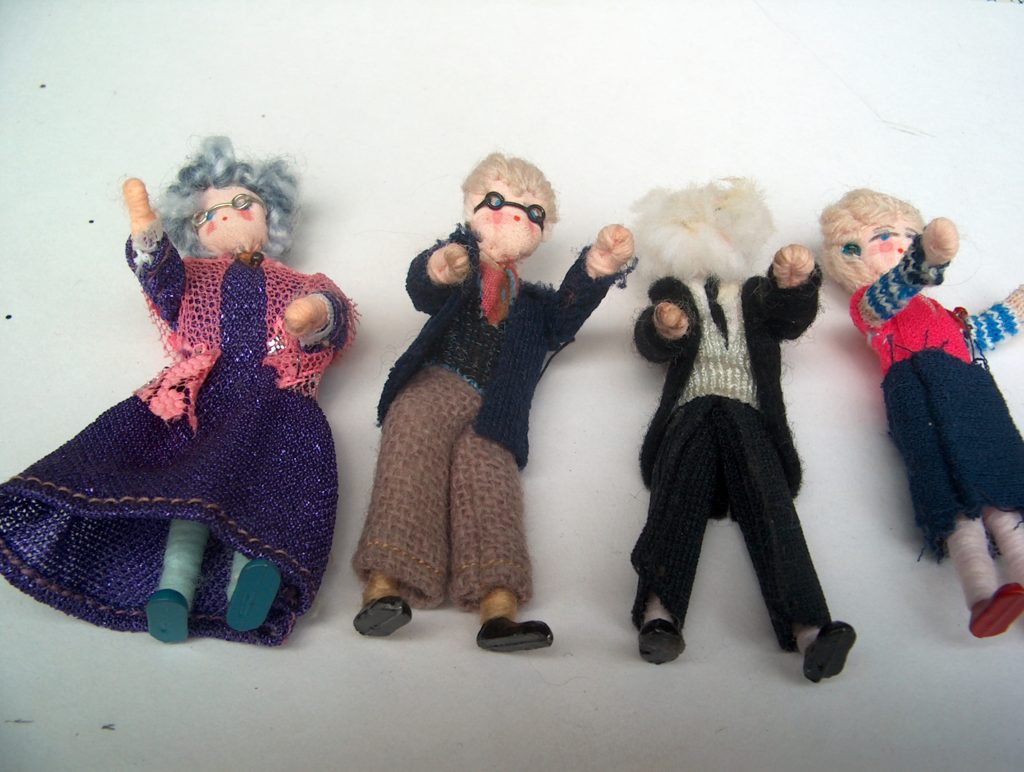
The characters in the photo above were purchased brand new, directly from Miss Cohn. Two of them, the Grandpa and Granny, have the later ‘Little People’ label and all of them have 1980s Casting-line feet.
Other Grecon Items
Brooches/Lapel Pins
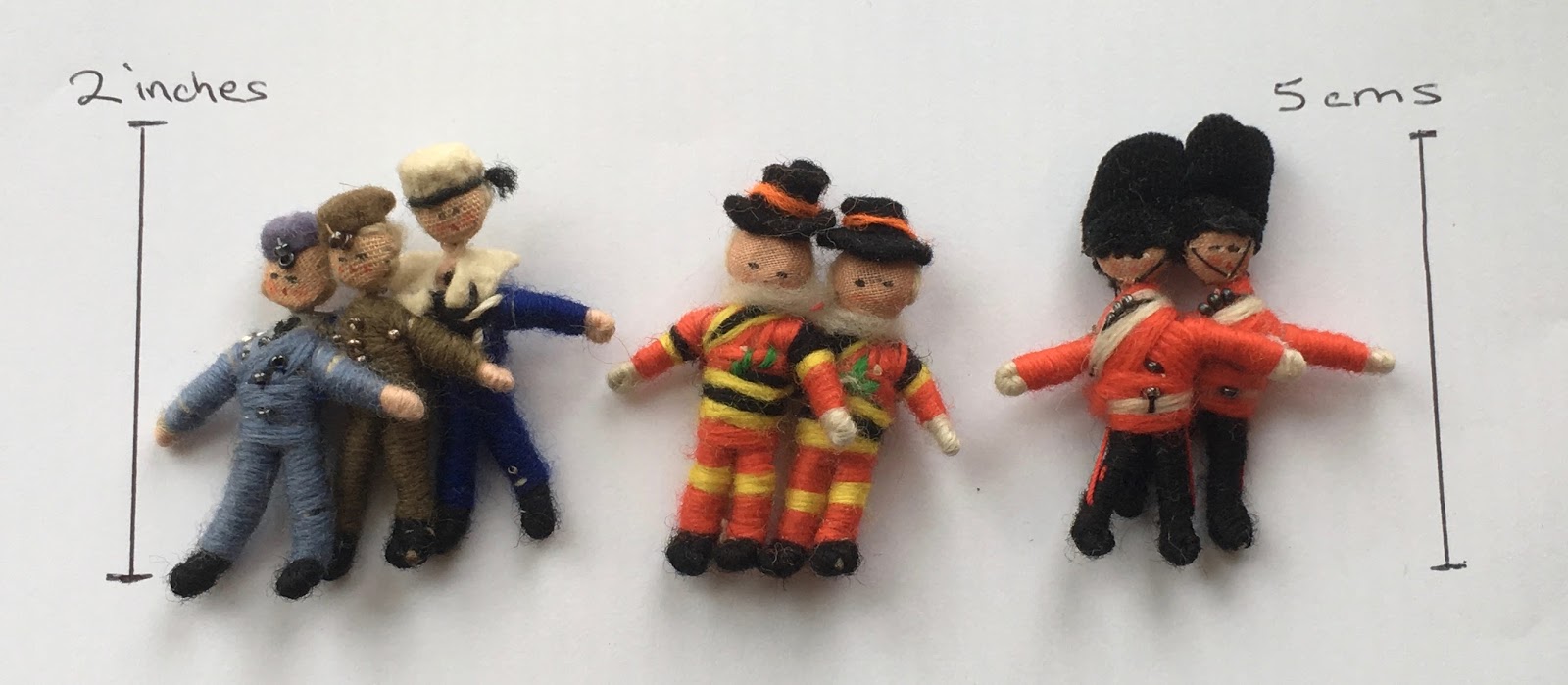
Amongst the very few post-WWII documents within the largely pre-WWII Grete Cohn archive I have viewed, were the Certificates of Registration of Design with The [British] Patent Office, for figures like those in the photo above.
I don’t know if the little figures were already in production prior to the design registration, but the certificates are all dated 9th of October, 1939 – so just one month after the start of WWII.
I saw three registrations, each referring to a black and white photo of a single figure (unlike the doubles and triple seen in the photo above): an airman, a soldier and a grenadier guard, all exactly like those in the above photo – although since the photos were black and white, I can’t be 100% certain of the uniform colours.
Each design was described only as “a doll, the predominating material being of textile fabric”.
The photos in the registrations were front- and back-views of the figures and the back-view did not include a safety pin.
However, there were a further two items relating to these little characters in the archive:
One was a cutting from a 1939 edition of Woman’s Weekly with an advert on it for a “little woolly hand-made brooch”, available from Peter Robinson’s in Oxford Street, London and including a drawing of a brooch featuring a pair of soldiers.
The second item was a Dickins & Jones catalogue from Christmas 1941 which included an entry for: “Service Favours. Wear a Mascot Brooch to show your preference for airmen, soldiers, jack tars, or naval officers.” and featured a drawing of a pair each of soldiers, sailors and naval officers.
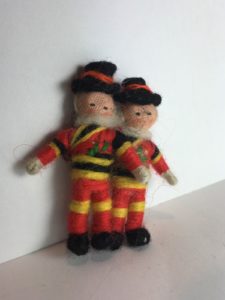
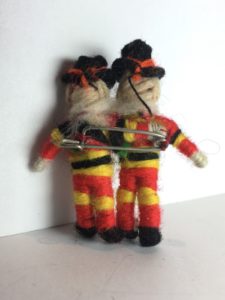
I think that all three of the brooches in the photo at the top of this section on Brooches will date to the 1930s/40s, however, I believe that the above brooch, featuring Beefeater guards, is the earliest because, in common with the earliest Grecon dolls, these little fellows have heads made from a small half-round wooden button/bead (padded at the back) with a hole through the middle. This probably dates them about 1936-1939.
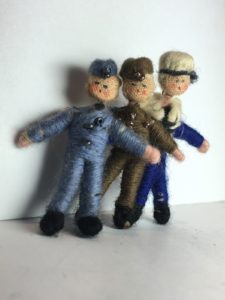

These chaps clearly represent the British Airforce, Army and Navy and it’s likely that they were made and sold during WWII (1939-1945) to raise money for ‘the war effort’.
They have completely padded, soft heads – no wooden bead/button in there. The pin on the back is the same as on the Beefeater brooch, but I think that the soft heads indicate that they are probably slightly later in date and that would fit with the WWII dates too.
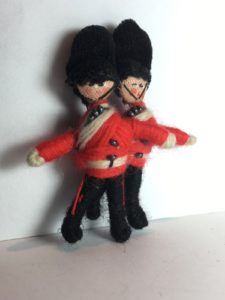
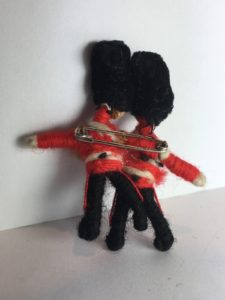
And that just leaves these little Grenadier Guards in their bearskin hats which are made from a lovely soft velvet. Again, the heads are entirely soft and don’t contain a wooden bead/button.
I am certainly no expert on safety pins but the one on the back of this brooch looks to be to be of a later design to the others since the pin point is completely enclosed in a safety guard in much the same way they are on modern safety pins.
Being Grenadiers in dress uniform, as seen parading around Buckingham Palace, it’s possible that they were made for sale to tourists returning to London again after the war.

Another reason for thinking that these Grenadiers are the latest in date of the three brooches shown is that that they have distinctly sideways-looking eyes. That sideways glance seems to be a feature of Grecon dolls with later, slightly smaller Melon feet which I believe date to the end of the WWII and the mid 1940s (when lead for feet was harder to come by). Grecondale’s Captain Richard Clutch, seen above, is a prime example of the sideways-glancing smaller melon foot Grecon. The little dolls the [probably] earlier design registrations do not have the sideways-looking eyes.

These little figures don’t have safety pin in them but are the same size as the little brooches shown above. They look to me like they might represent a French maid, maybe flirting with a soldier from the French Foreign Legion.
It was also interesting to note that the figures shown in the registrations did not have the side-ways looking eyes seen on the grenadier guard shown above, which I guessed to be slightly later brooch, so that theory is looking good (or at least it’s yet to be disproved!)
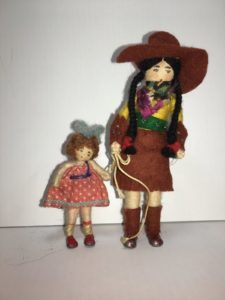
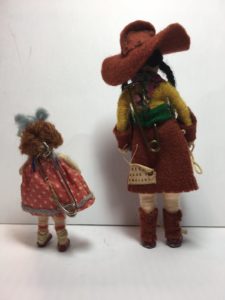
Some years ago I repatriated these normal dolls’ house-size Grecon dolls to the UK from Canada and found that they both had safety pins in the back. Presumably they were intended to be worn as brooches.
The question is, were they sold like this or did the person who bought them add the safety pins?
If I had to guess, I think I’d say that the owner added the safety pins. Both of these dolls came to me from Canada and they came together but their pins are different so I’m thinking that someone just added what safety pins she had in her sewing box to convert them into brooches. But, that’s just my guess and unfortunately, unless new information such as old adverts or catalogue entries come to light, we might never know real the answer.
Outfits
Here are some examples of the different characters produced (unless otherwise indicated, these are from my own collection):
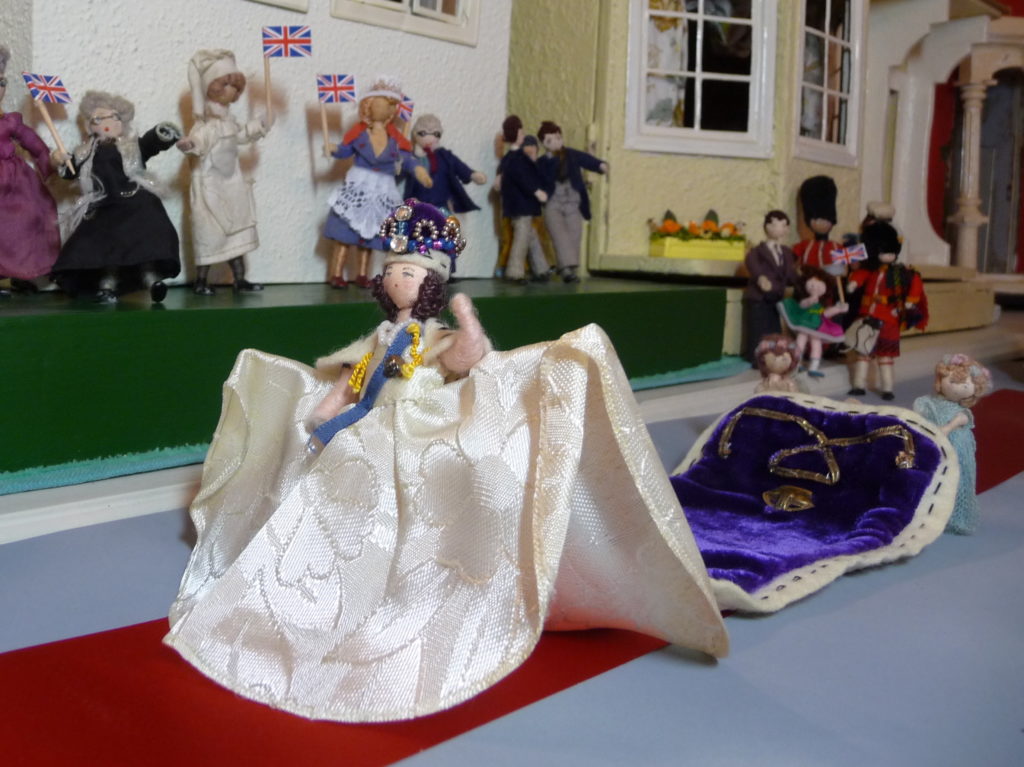


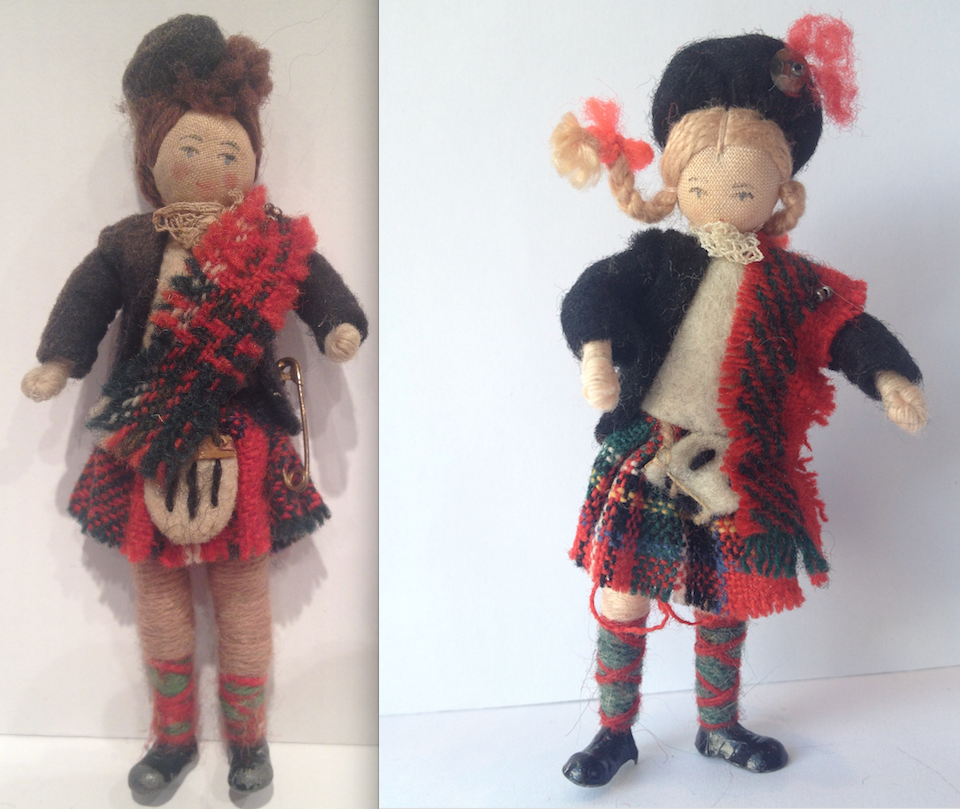
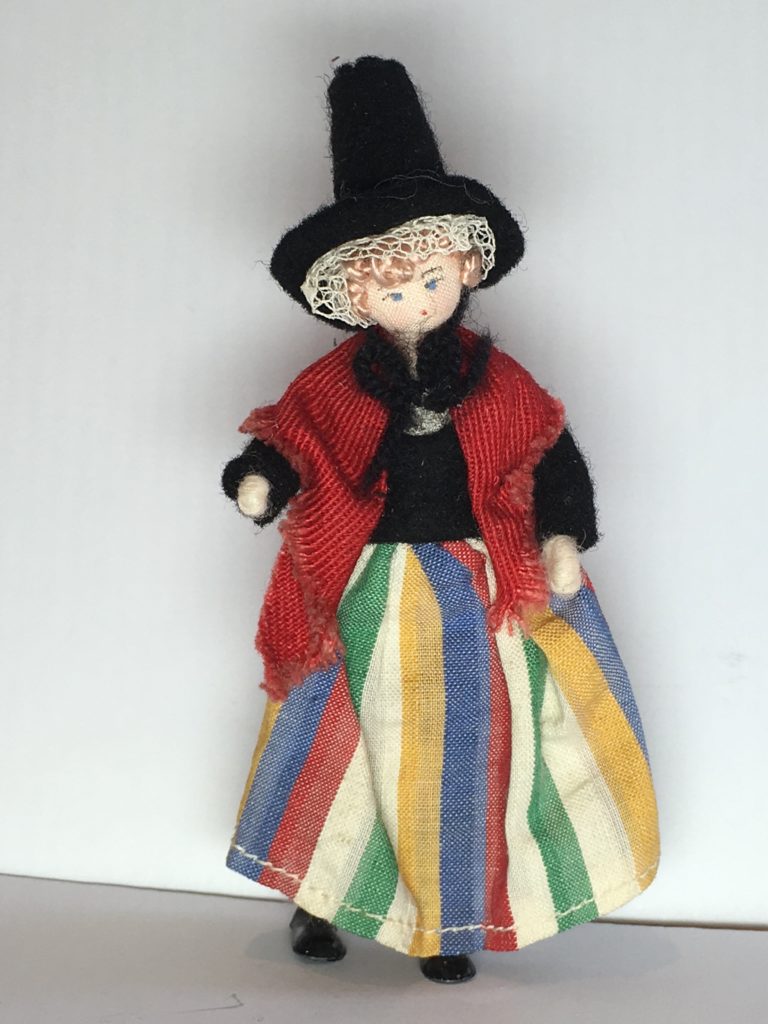
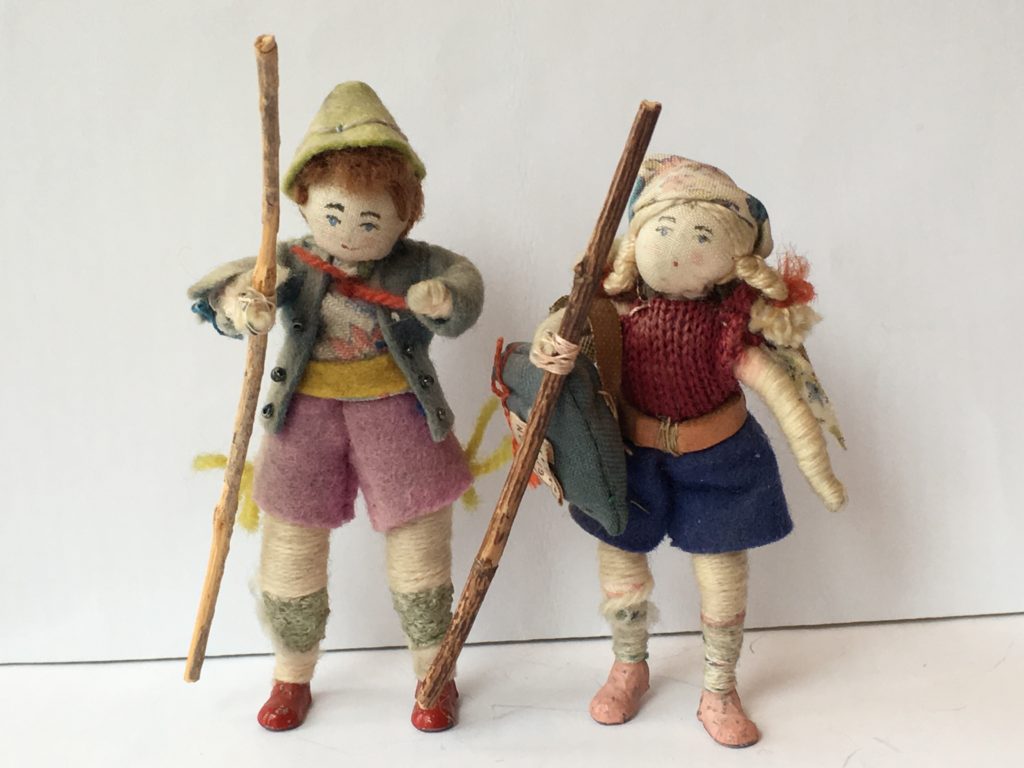
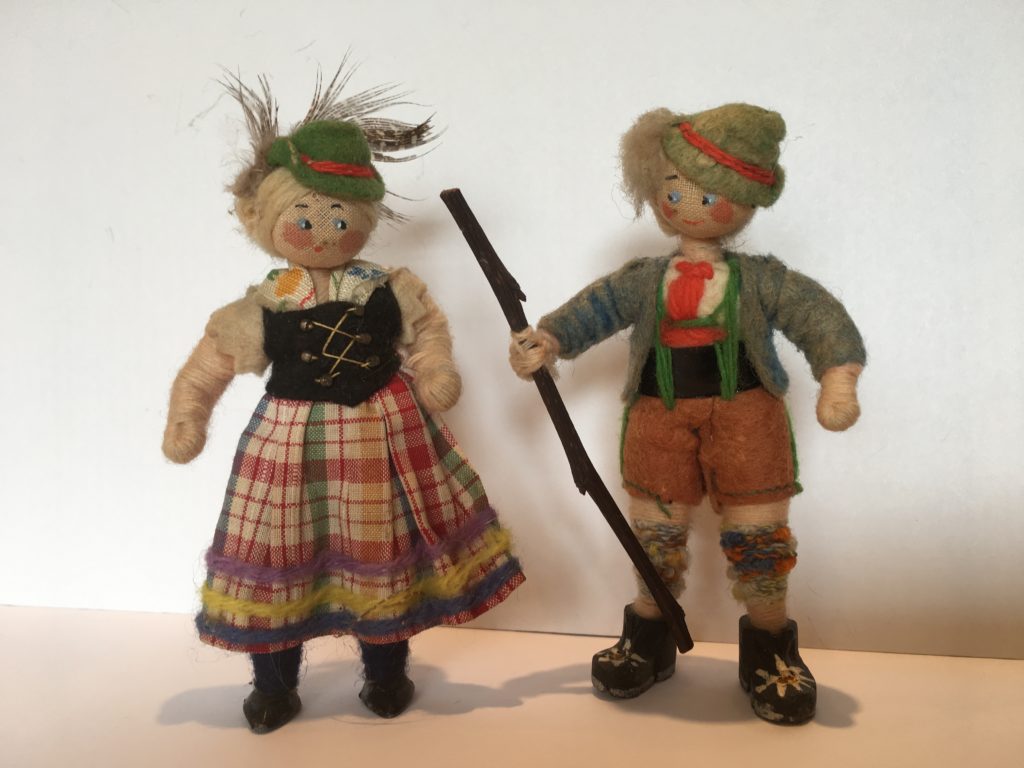
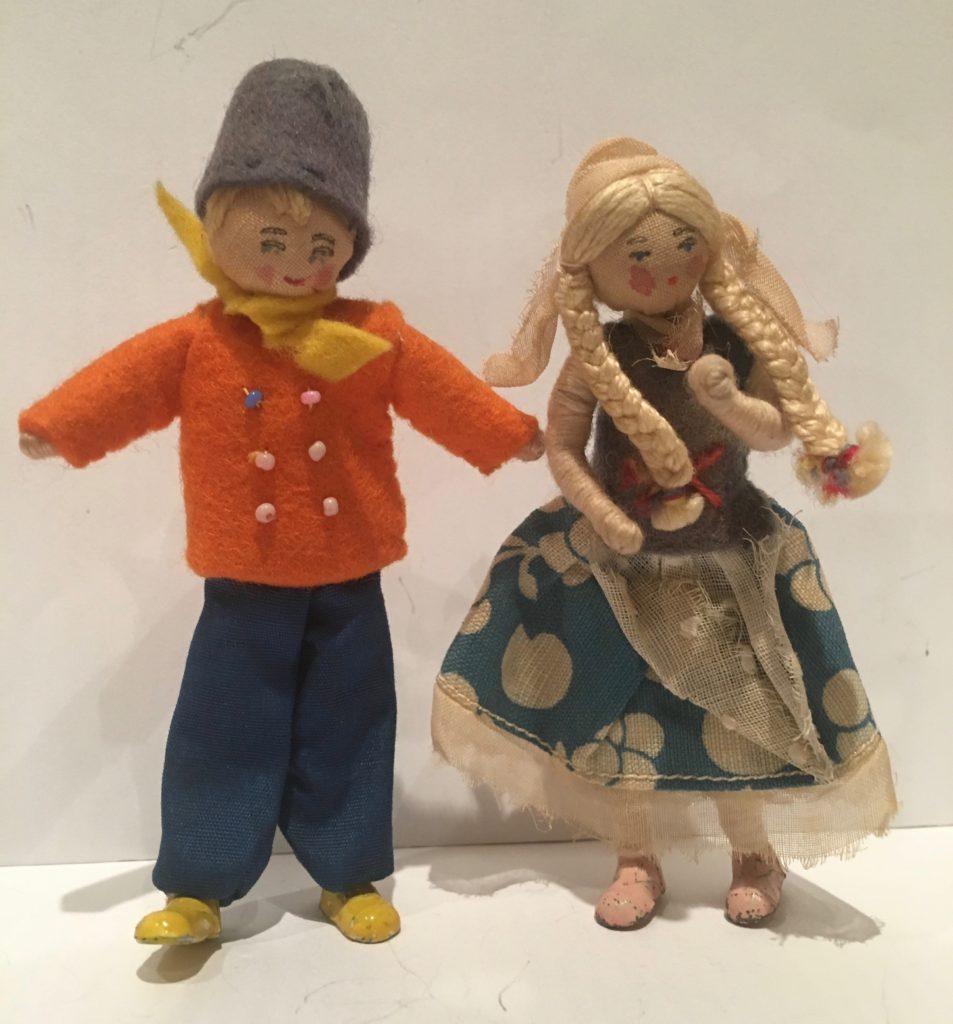
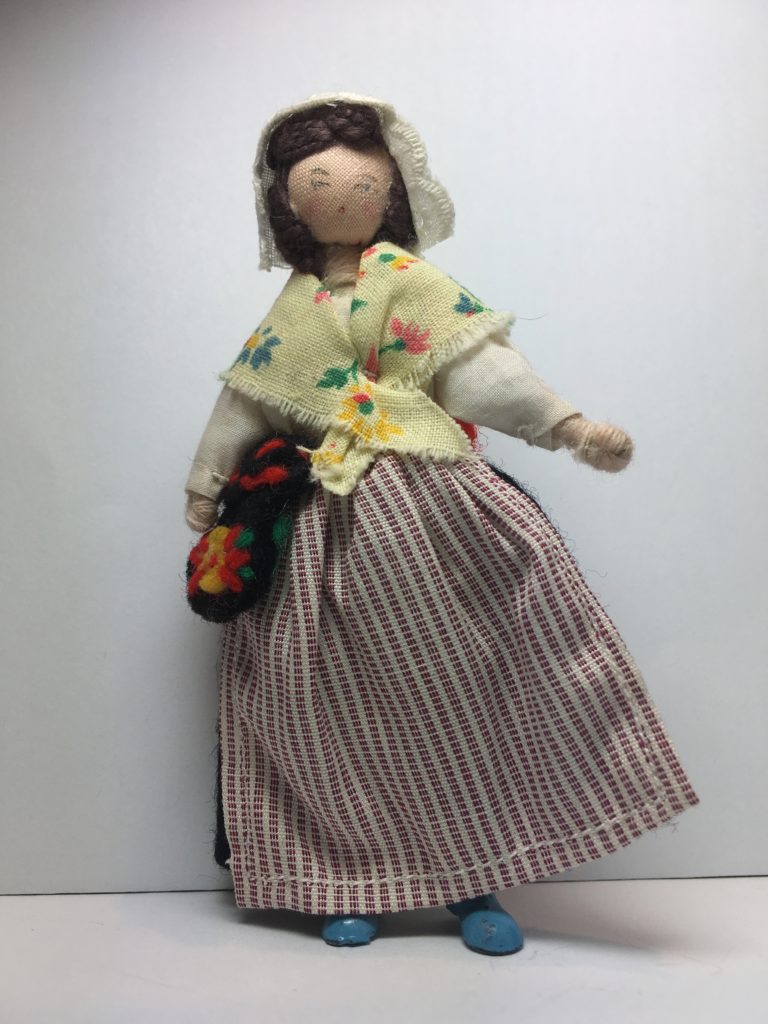
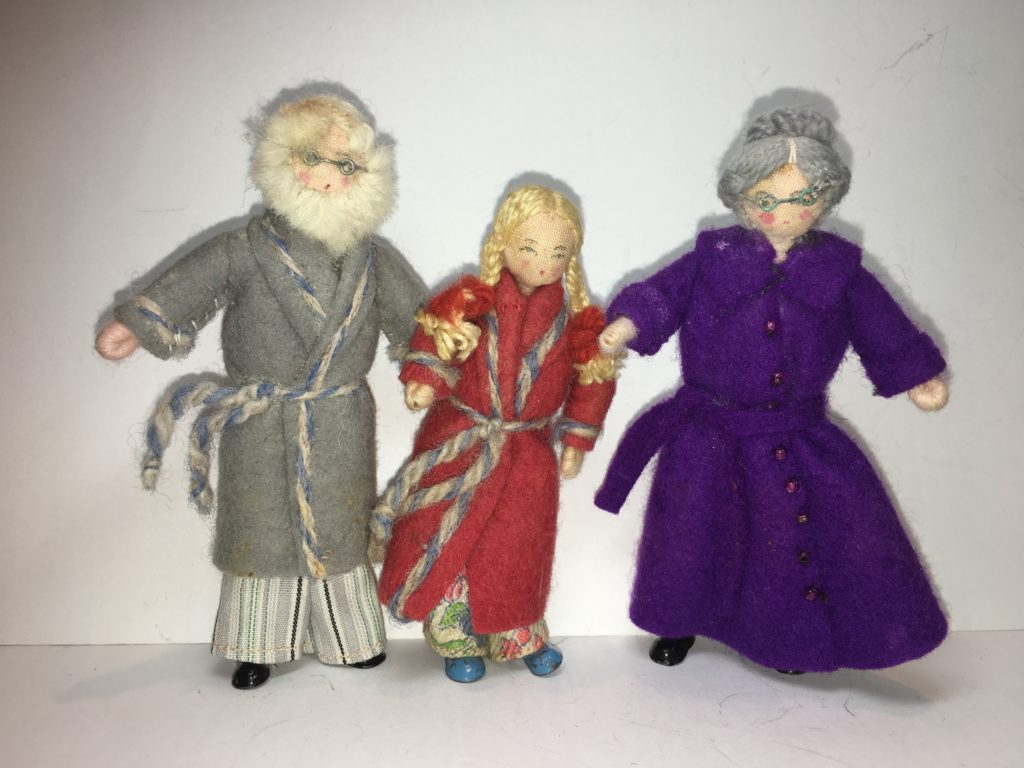
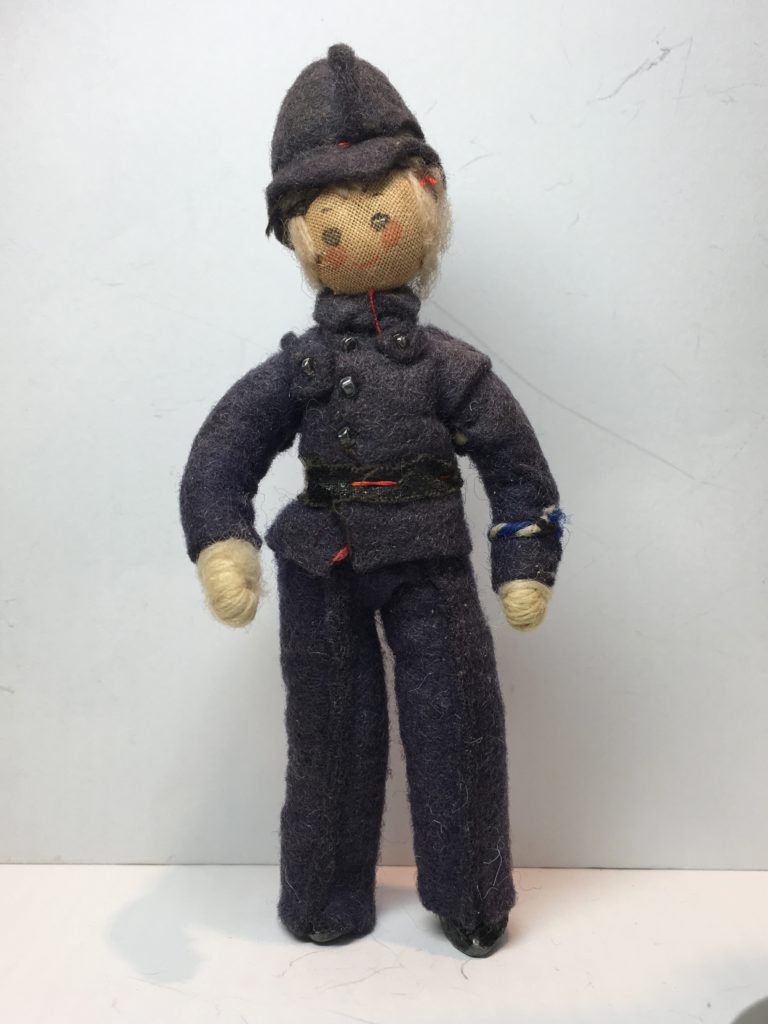
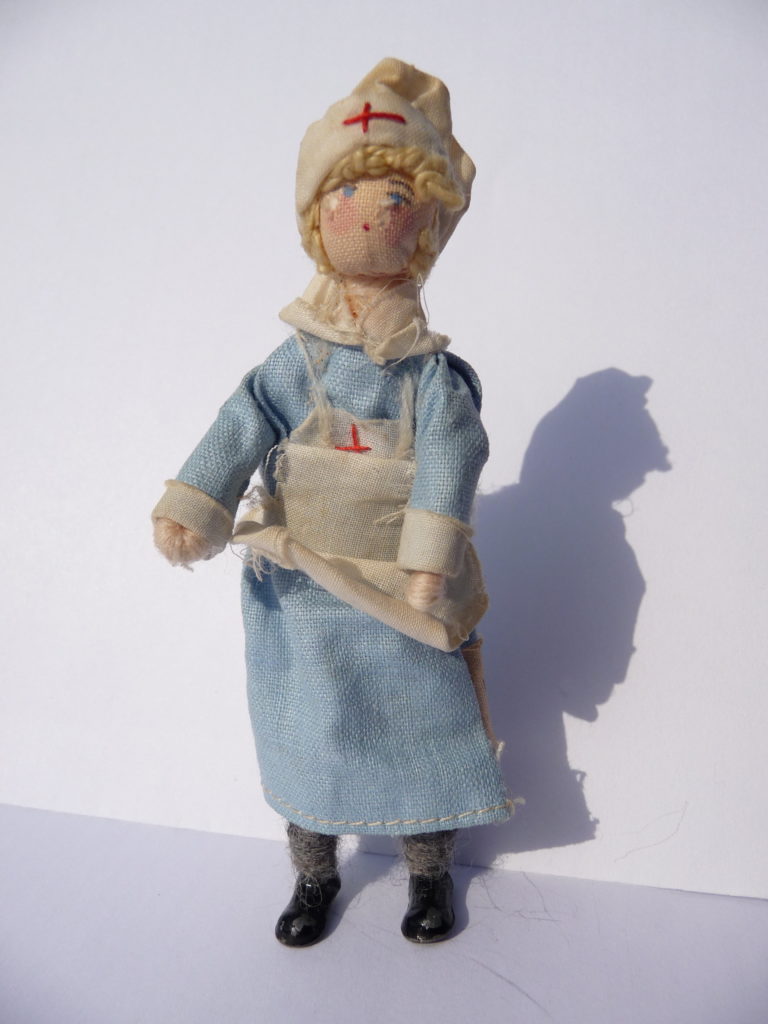
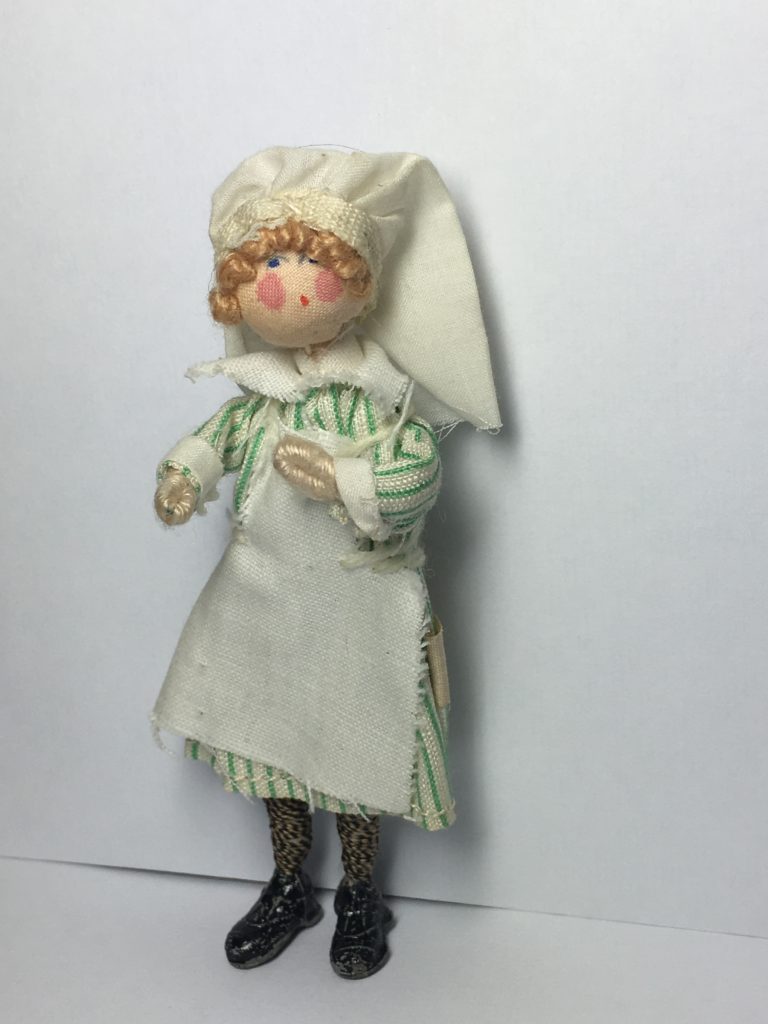
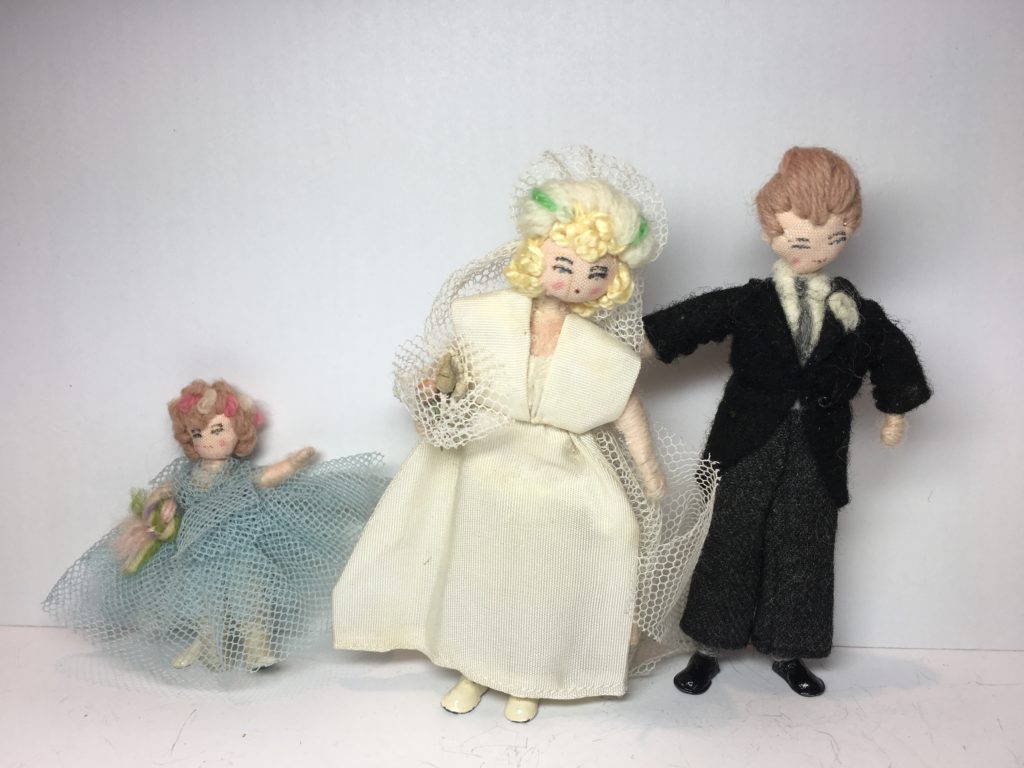

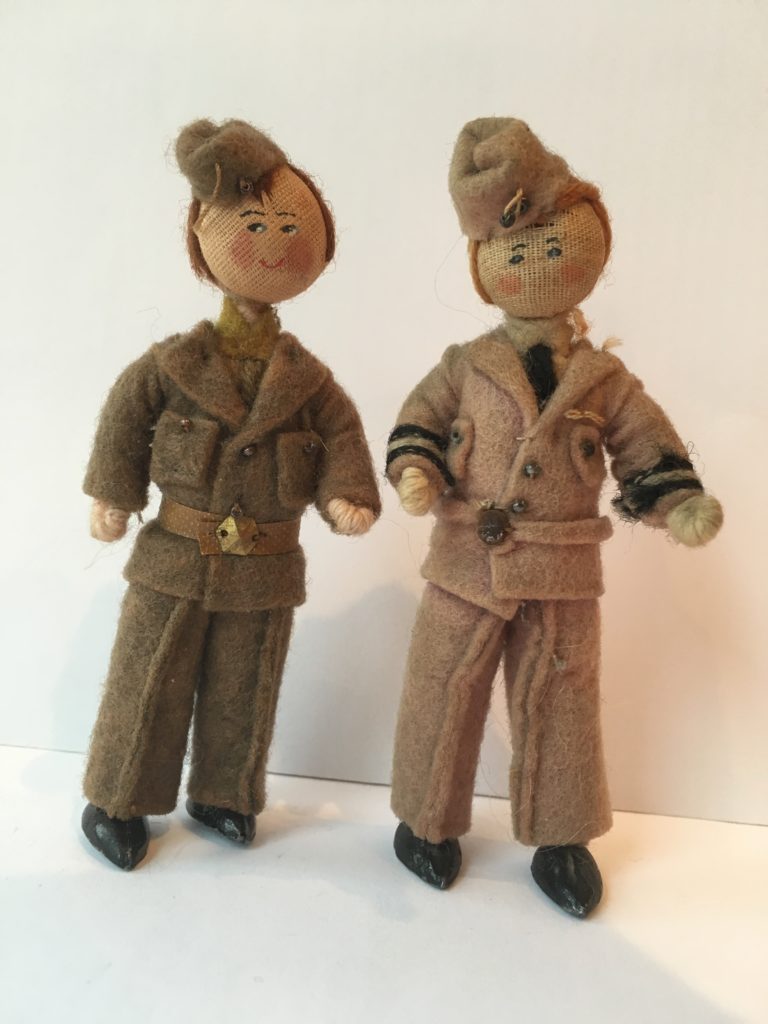
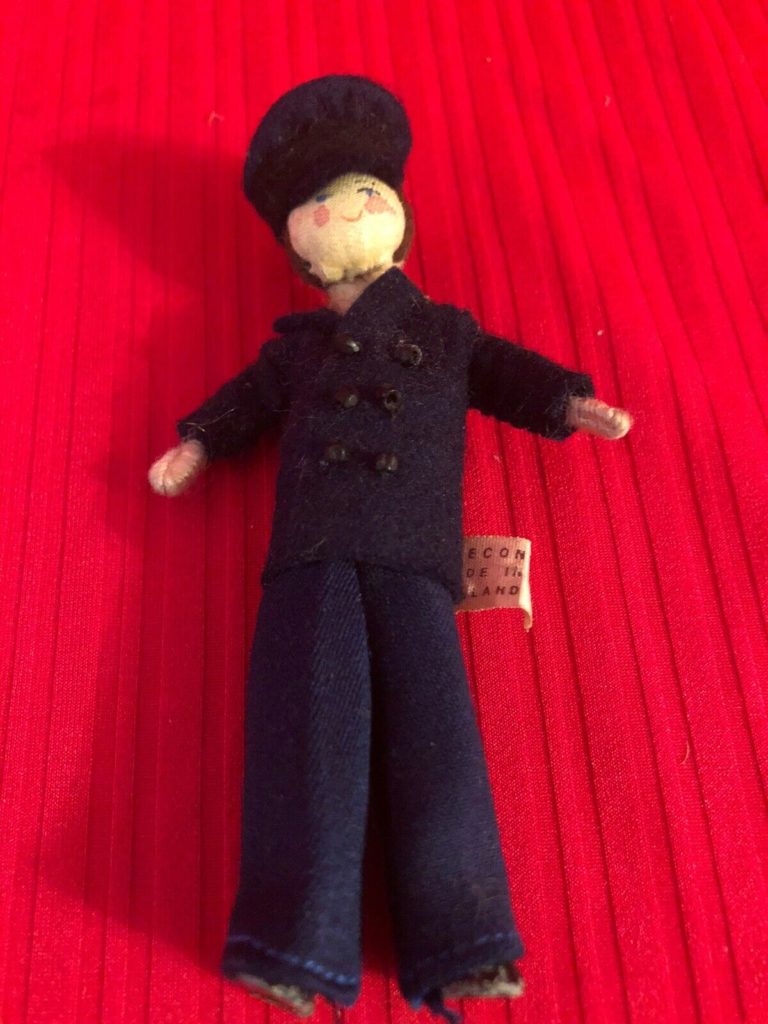
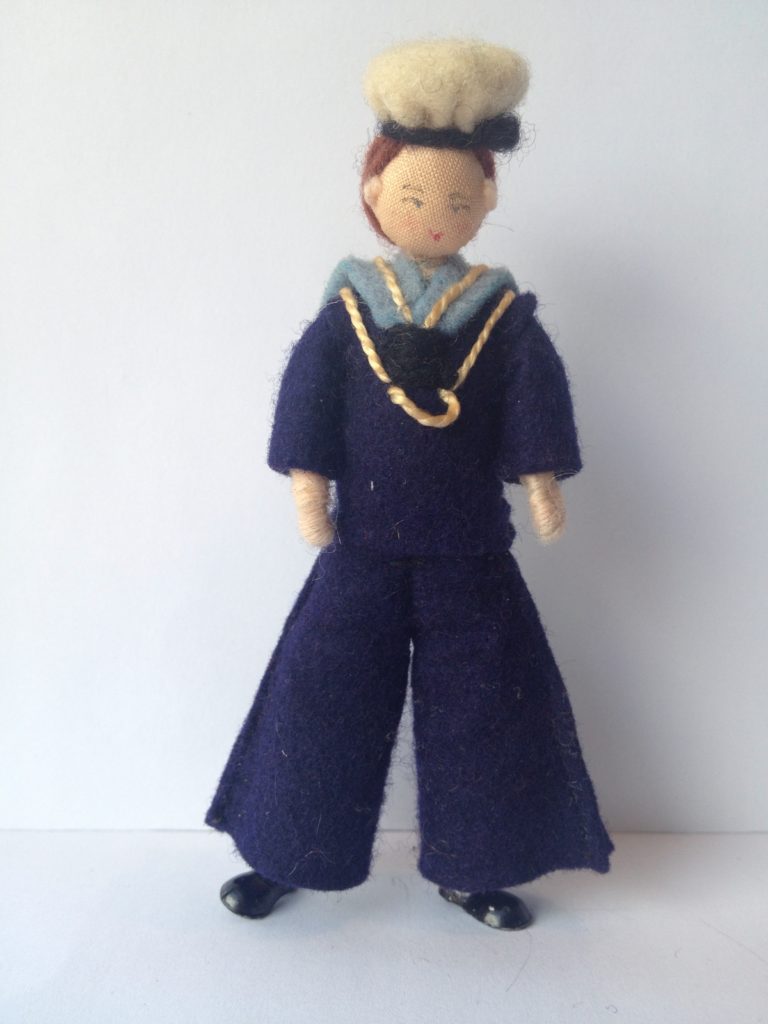

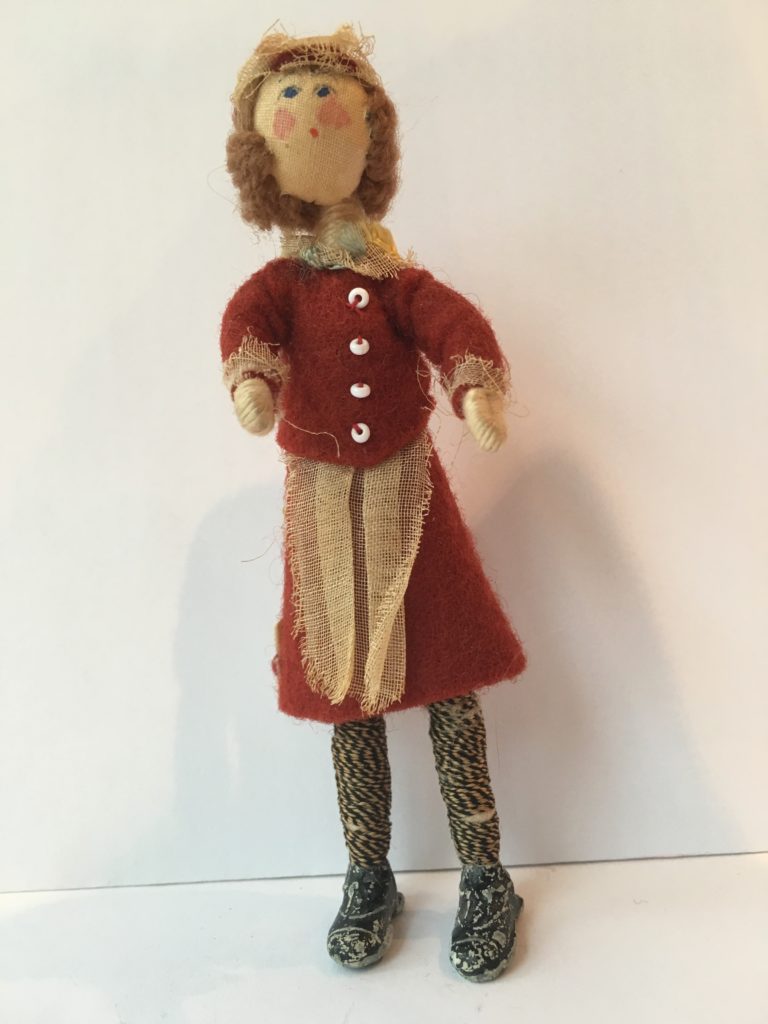

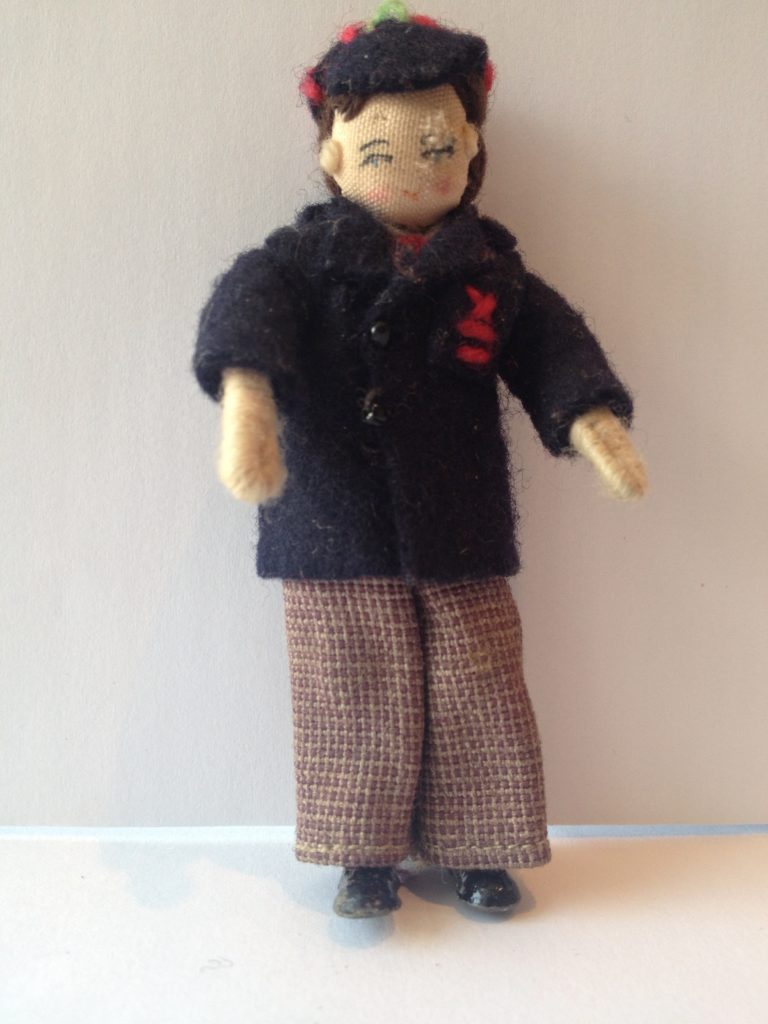
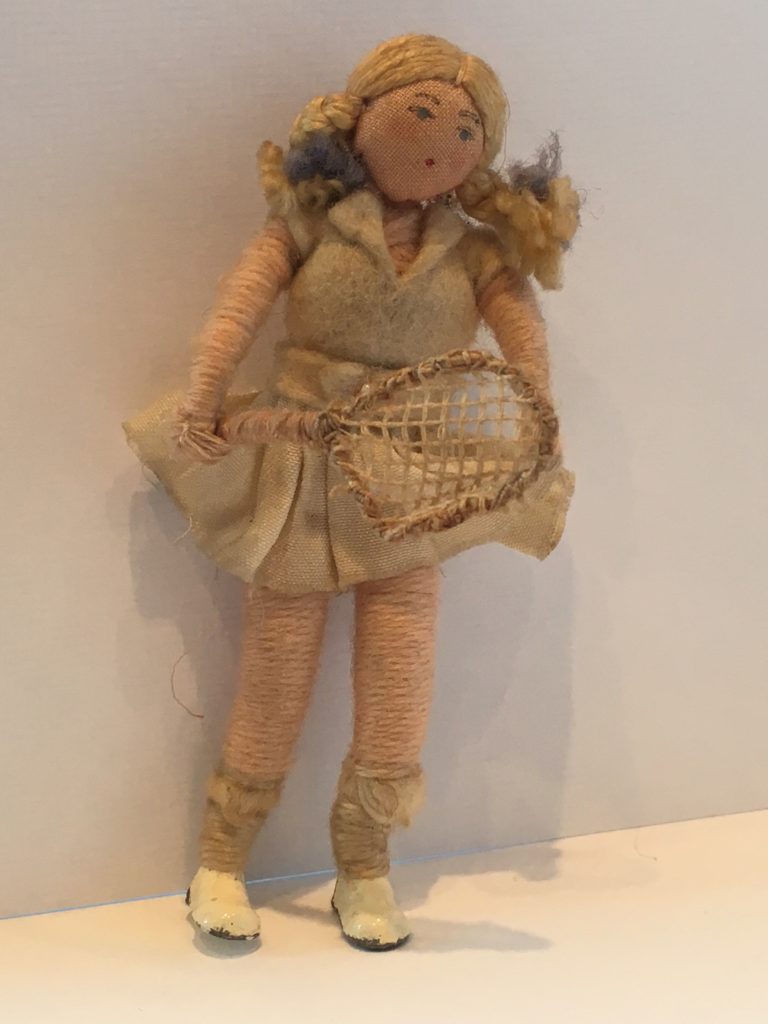
This section is to be continued – many more different outfits to be added..!
_______________________________
Still to come:
Faces/Hair, Dating, Miscellaneous.
Sources
-
- Ancestory.co.uk
-
- ‘Bartons Model Homes’, Marion Osborne, 1987.
-
- ‘Dollhouse & Miniature Dolls 1840-1990’, Marcia & Bob Tubbs with Dian Zillner, 2009.
-
- Grace’s Guide to British Industrial History.
-
- ‘Grecon Dolls’, Rosemary Myers, Dolls House Past & Present website eMagazine, Issue 16, March 2013.
-
- ‘Grecon Little People’, Patricia S. Planton, ‘Doll Read’ magazine, Feb 2004.
-
- ‘Memories of Grete Cohn’, John ‘Clif’ Hardy, Dolls Houses Past & Present website eMagazine, Issue 18, September 2013.
-
- Rosemary Myers – life-long collector of Grecon dolls.
-
- ‘The Collector’s Guide to British Dolls since 1920’, Colette Mansell, 1983.
-
- The London Gazette online archives.
-
- The National Probate Calendar.
-
- V&A Museum of Childhood online archive records.
-
- ‘Little People’, ‘International Dolls’ House News’ magazine, Volume 3, No. 4, Winter 1974/1975.